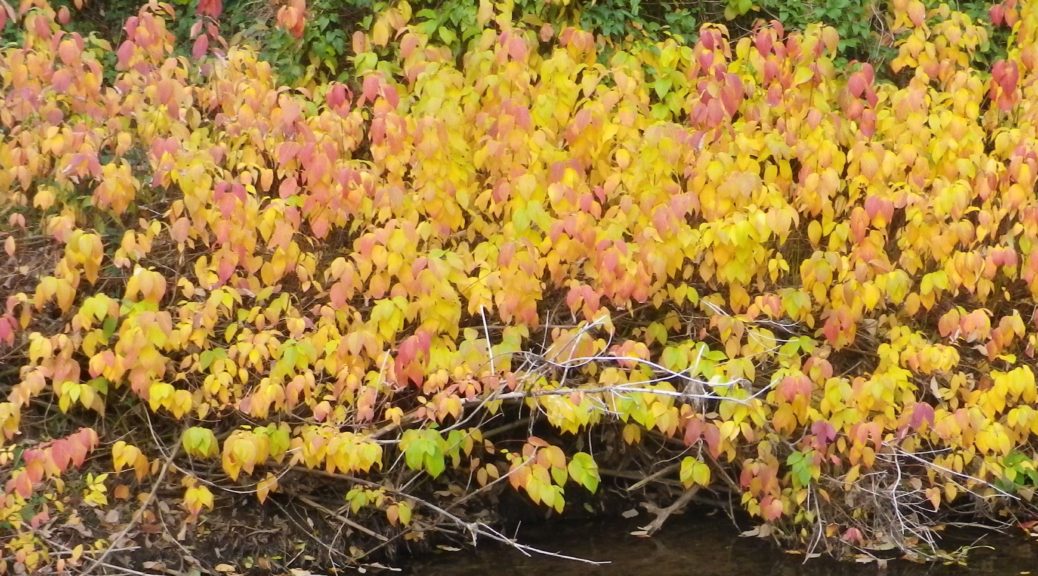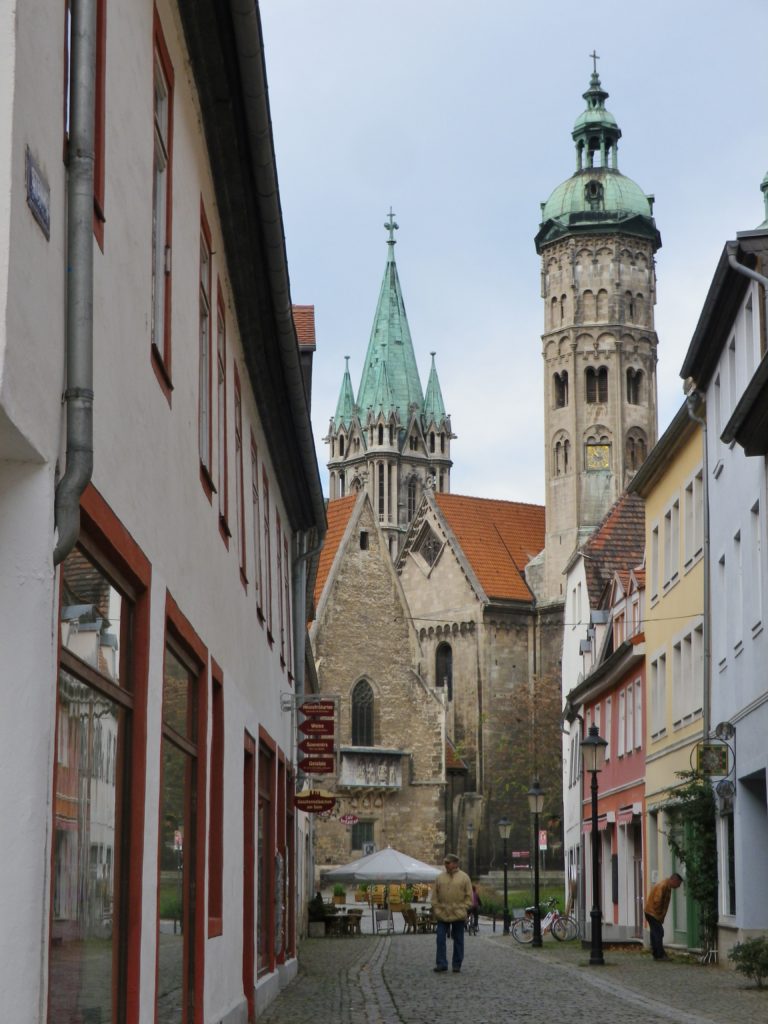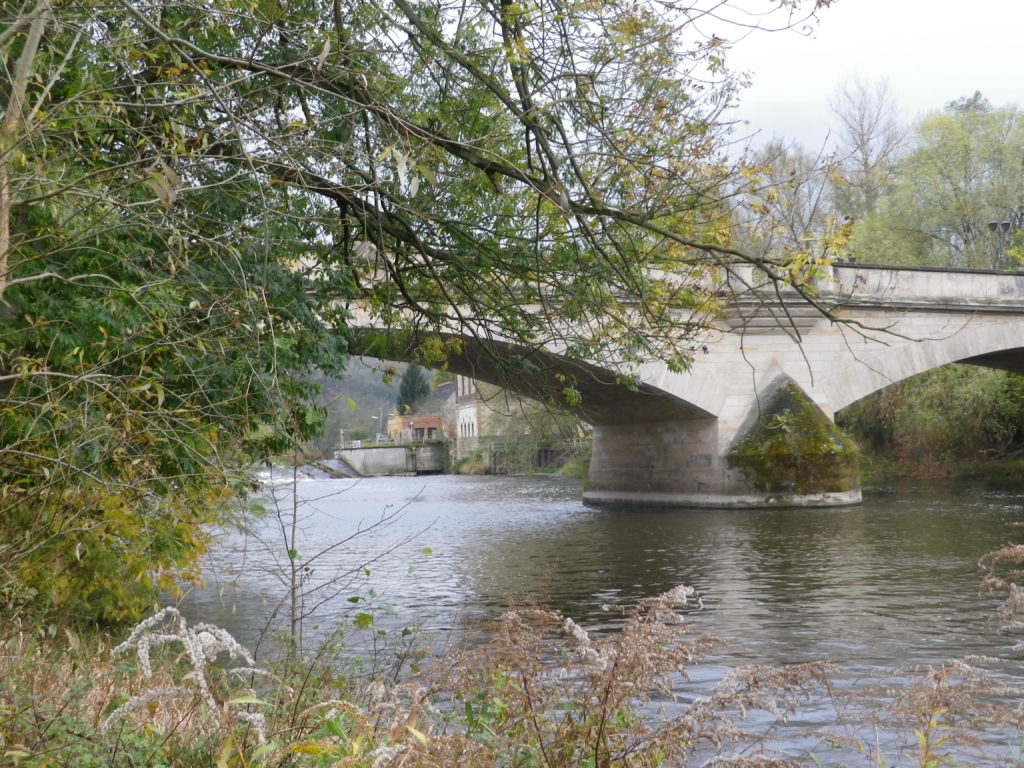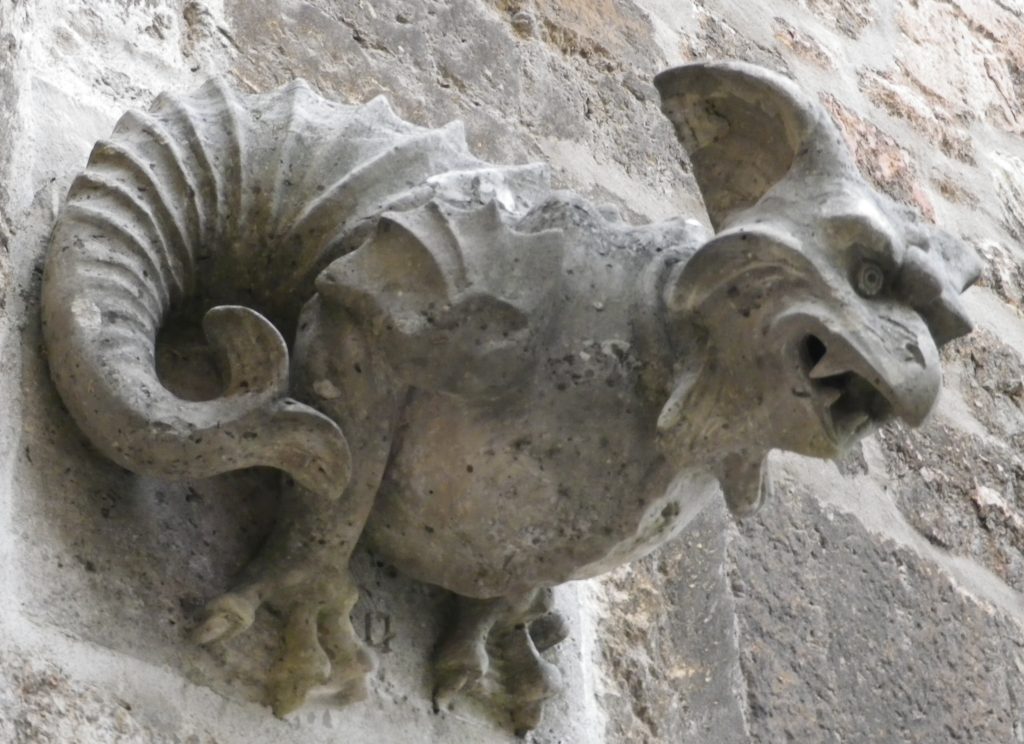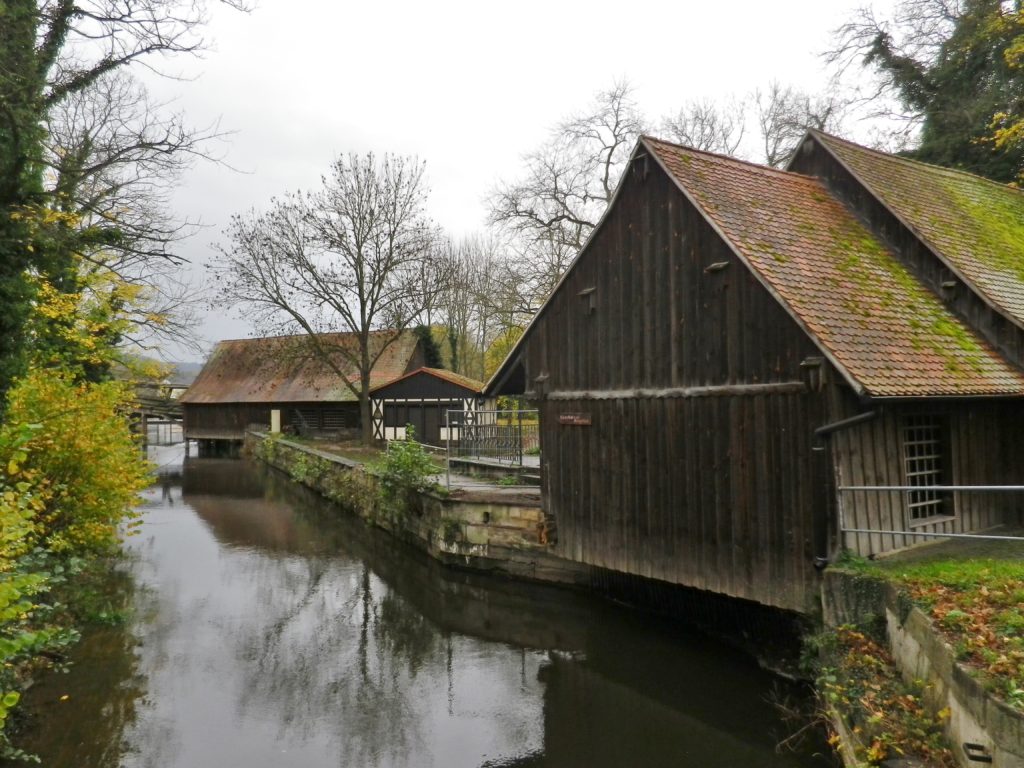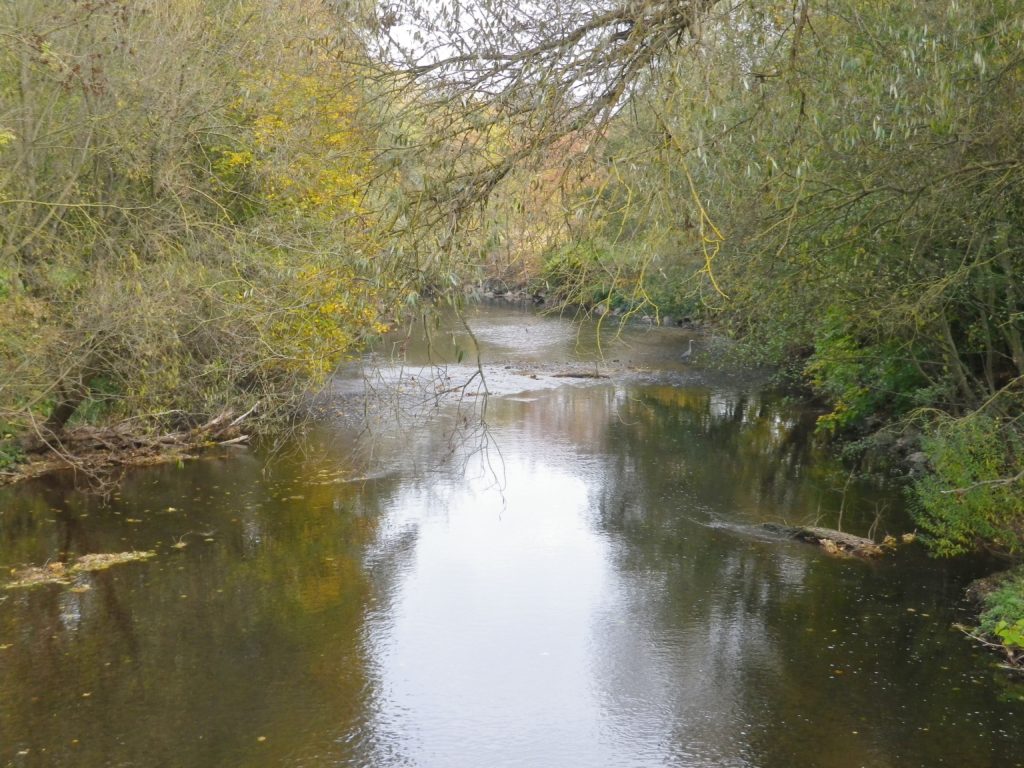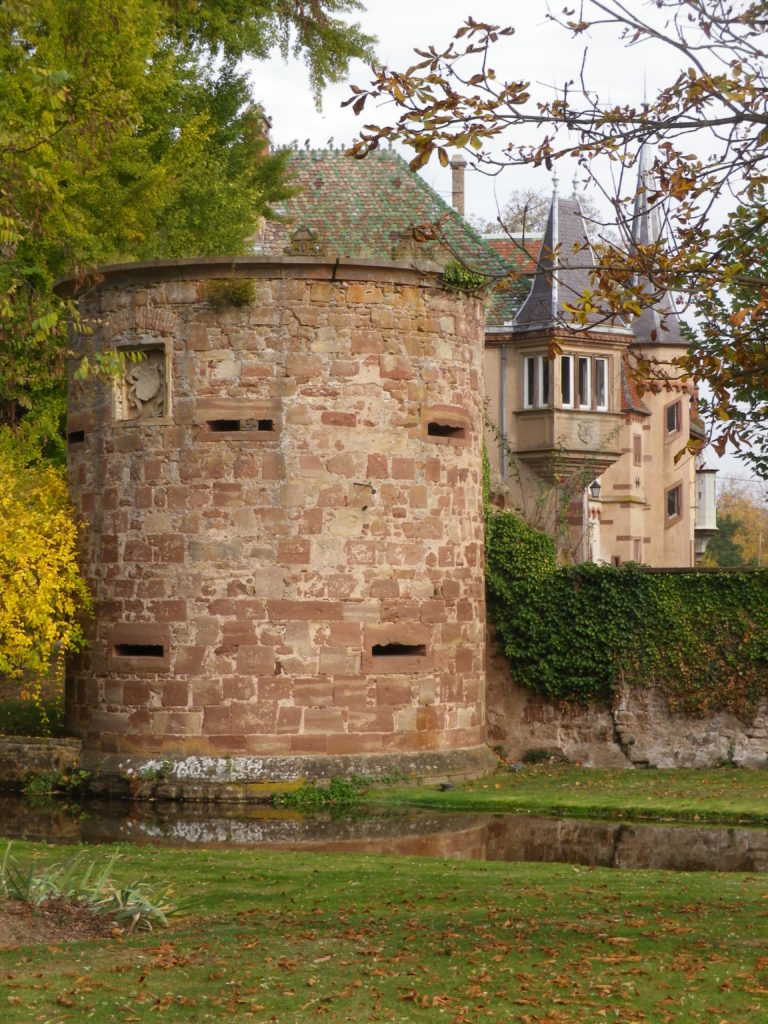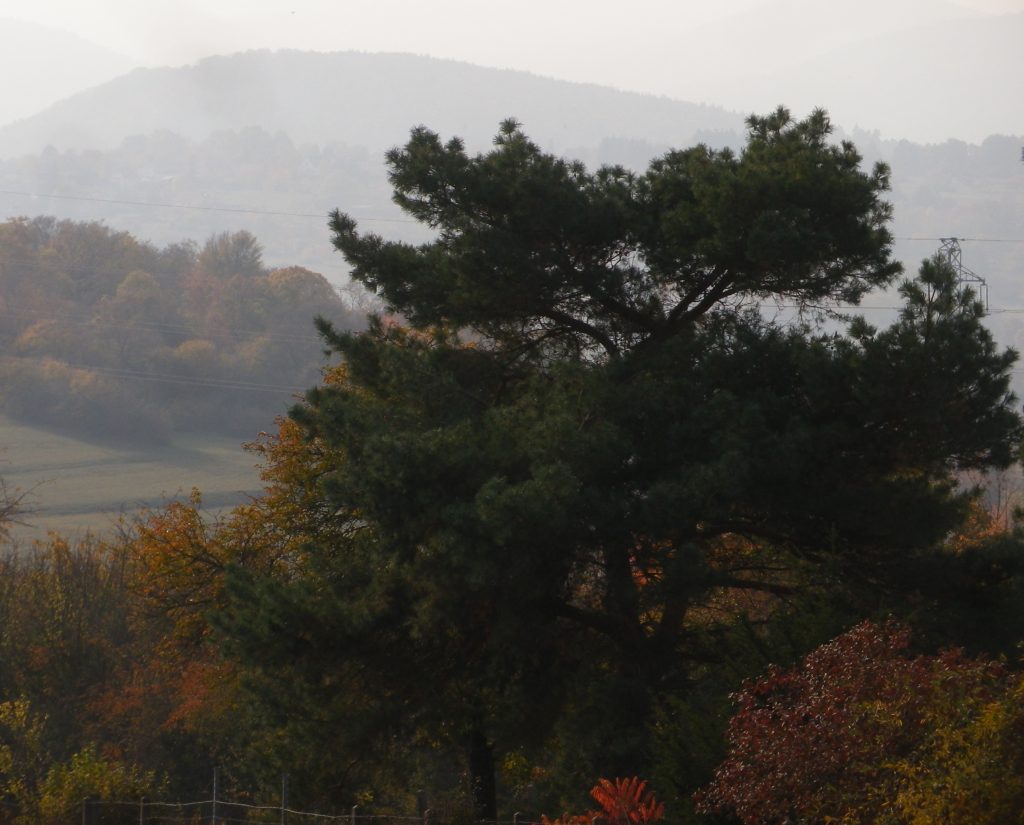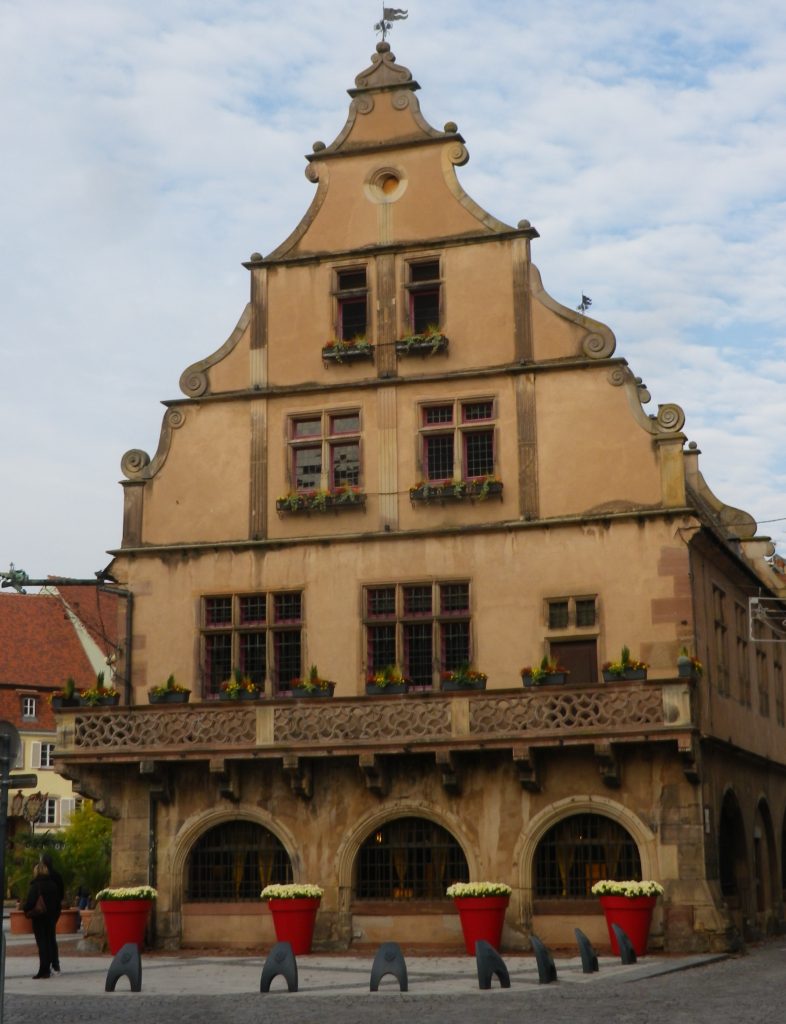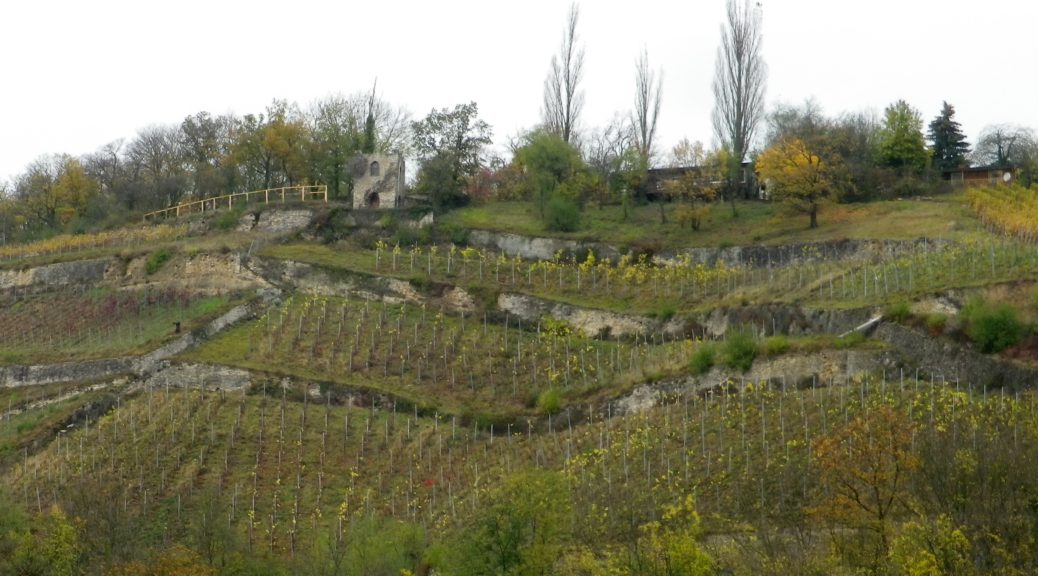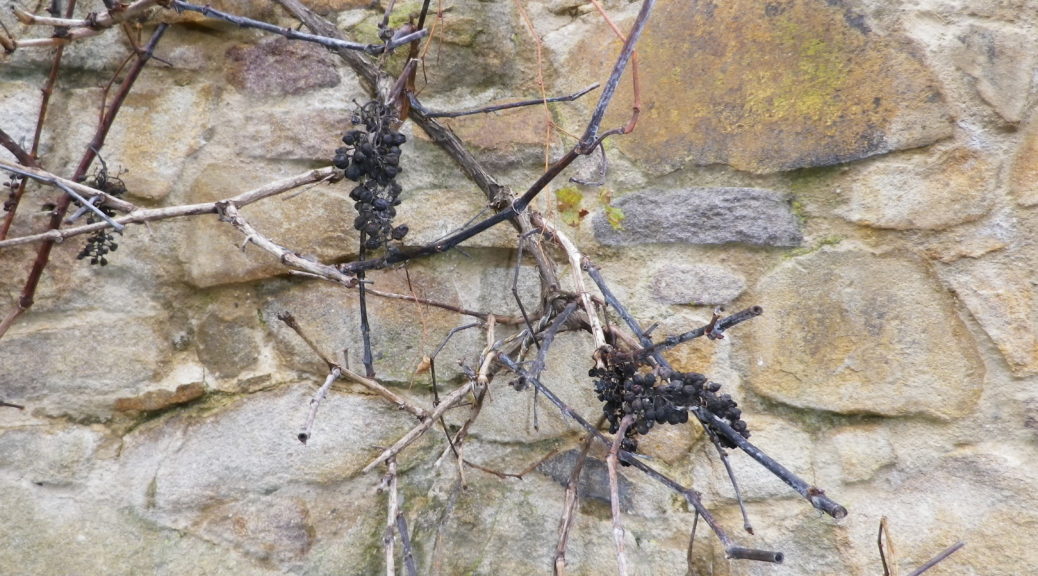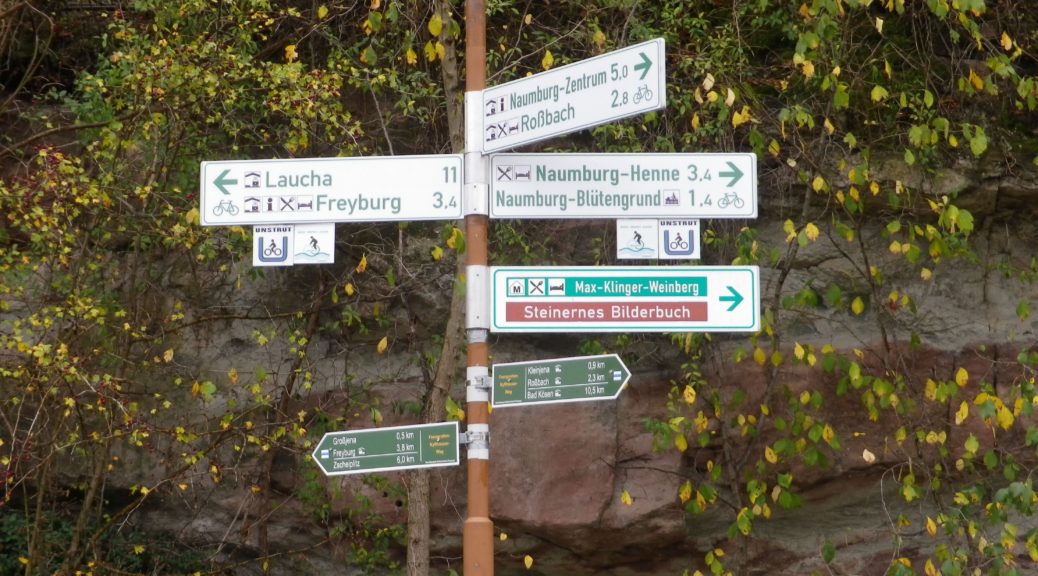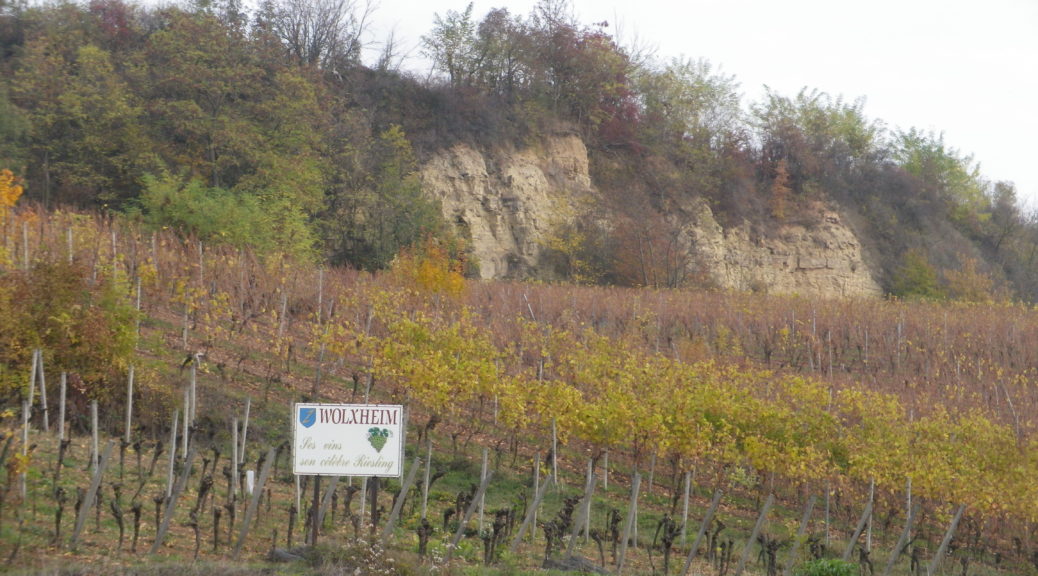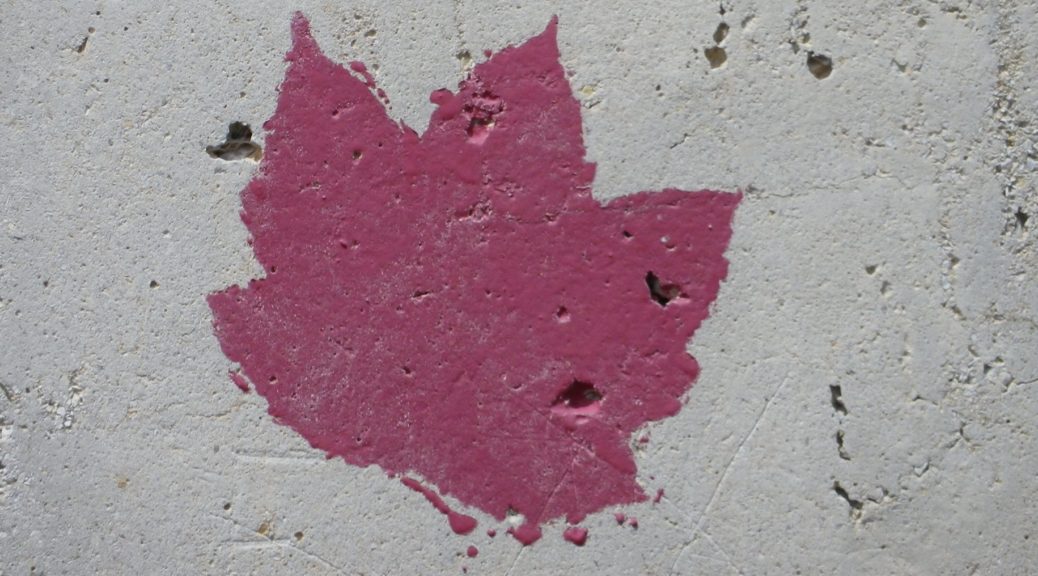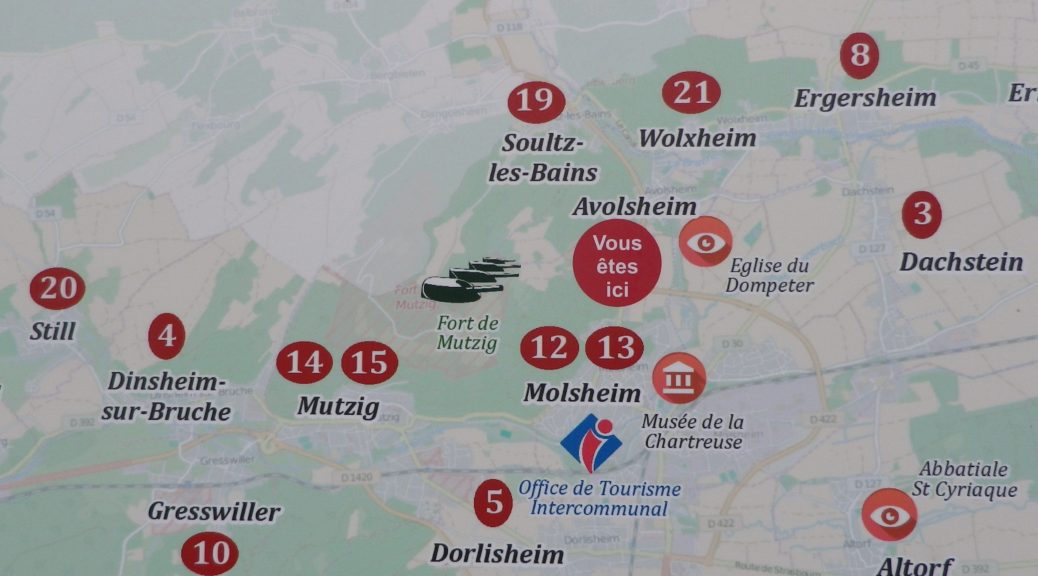Monthly Archives: November 2020
The Hike That Wasn’t
This may be the shortest post on record. Minutes away from Weimar, I gave a mighty tug on my luggage, stubbornly stuck under the train seat, only to have my knee, not my backpack, give way. Going down, using an old Anglo-Saxon cognate that caught the attention of the many modern-day German-speaking passengers, they graciously helped me off the train at the station. Months preparing for this two-day hike, hours of travel from Frankfurt, and in the end, no hike.
Fortunately, a friend and I had planned to meet at the station in Weimar, and he had a rental car. So off we went to Naumburg, just over the Thuringian border, in Saxony-Anhalt. Naumburg is a lovely old town with a spectacular medieval cathedral, (housing Disney’s Snow White evil stepmother look-alike – judge for yourself, below), and site of the trailhead for the Saale Weinwanderweg.
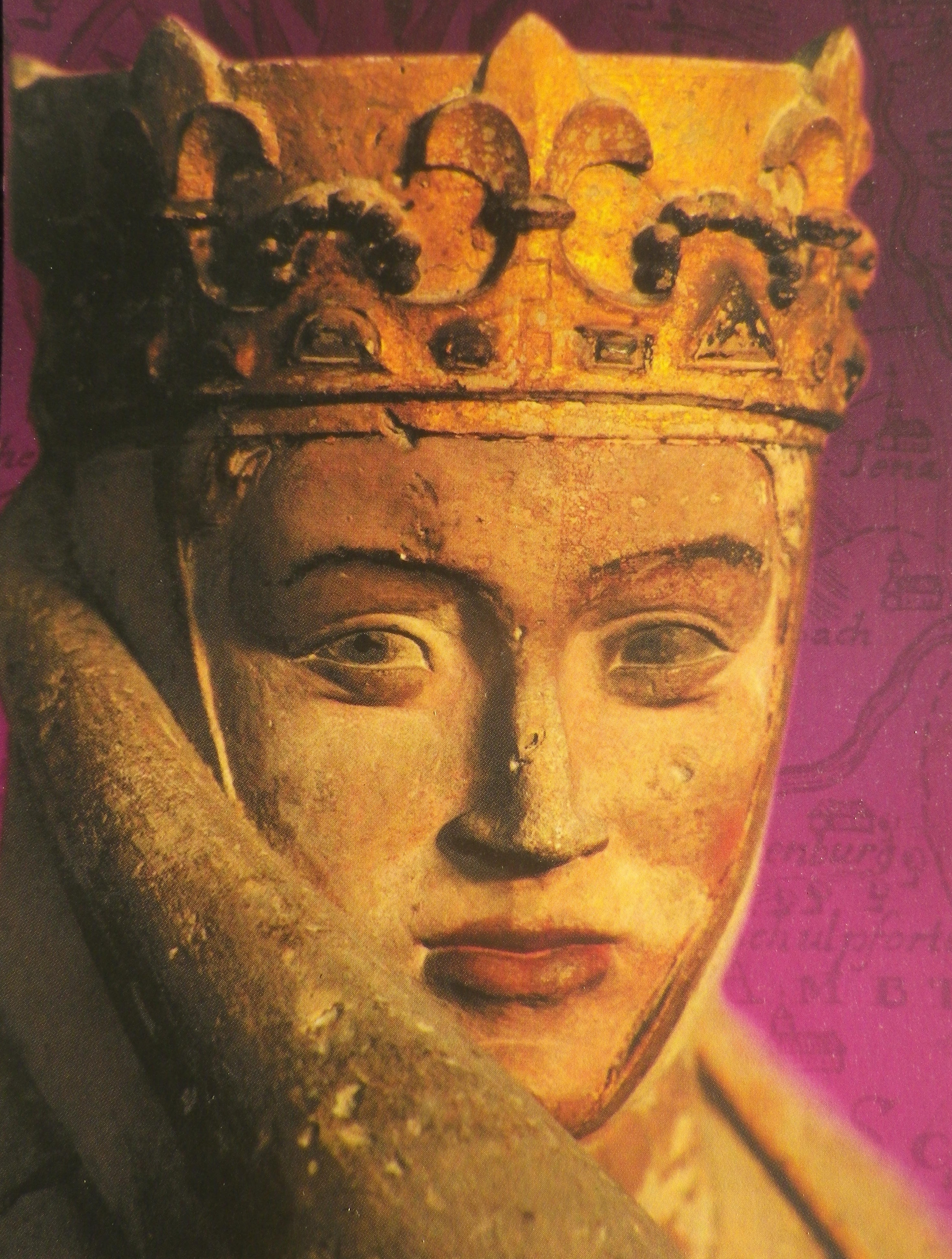
The trail commemorates the Saale-Unstrut wine region in Germany. It is one of two wine regions in eastern Germany, and the one with the northern most vineyards in Germany. These vineyards lie mostly on the south-facing hills and river banks lining the Unstrut and the Saale rivers (not to be confused with the Fraenkische Saale river, further south). Hence this trail partly follows along these two rivers. And the trailhead is located not far from where the two rivers meet, just outside Naumburg.
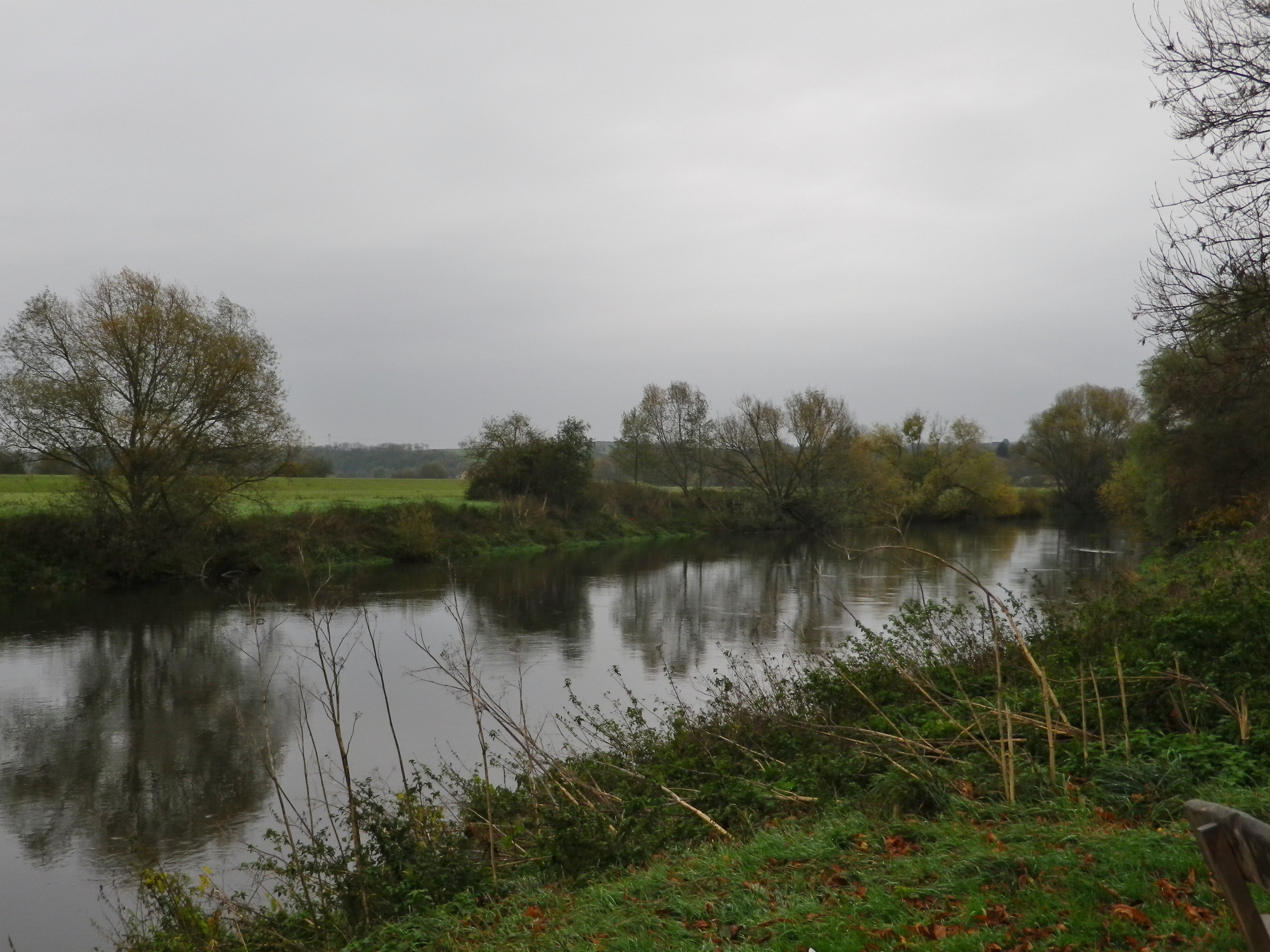
My friend, there to tour historical sites and peruse antique porcelain, graciously agreed to shuttle me to a series of points on the trail, accessible by car, where I could hop out, literally, to take photos. First stop, the trailhead. As evident by the photo below, this part of the trail is also a bicycle path, as were the subsequent sections I saw. It appeared that much of this trail could be biked, with a hybrid or mountain bike, from the looks of the sections I could reach. One caveat though, there are two sections higher up the hillsides, and through woods, that are probably a bit rougher, possibly suitable only for hiking. (There are cycling path alternatives though.)
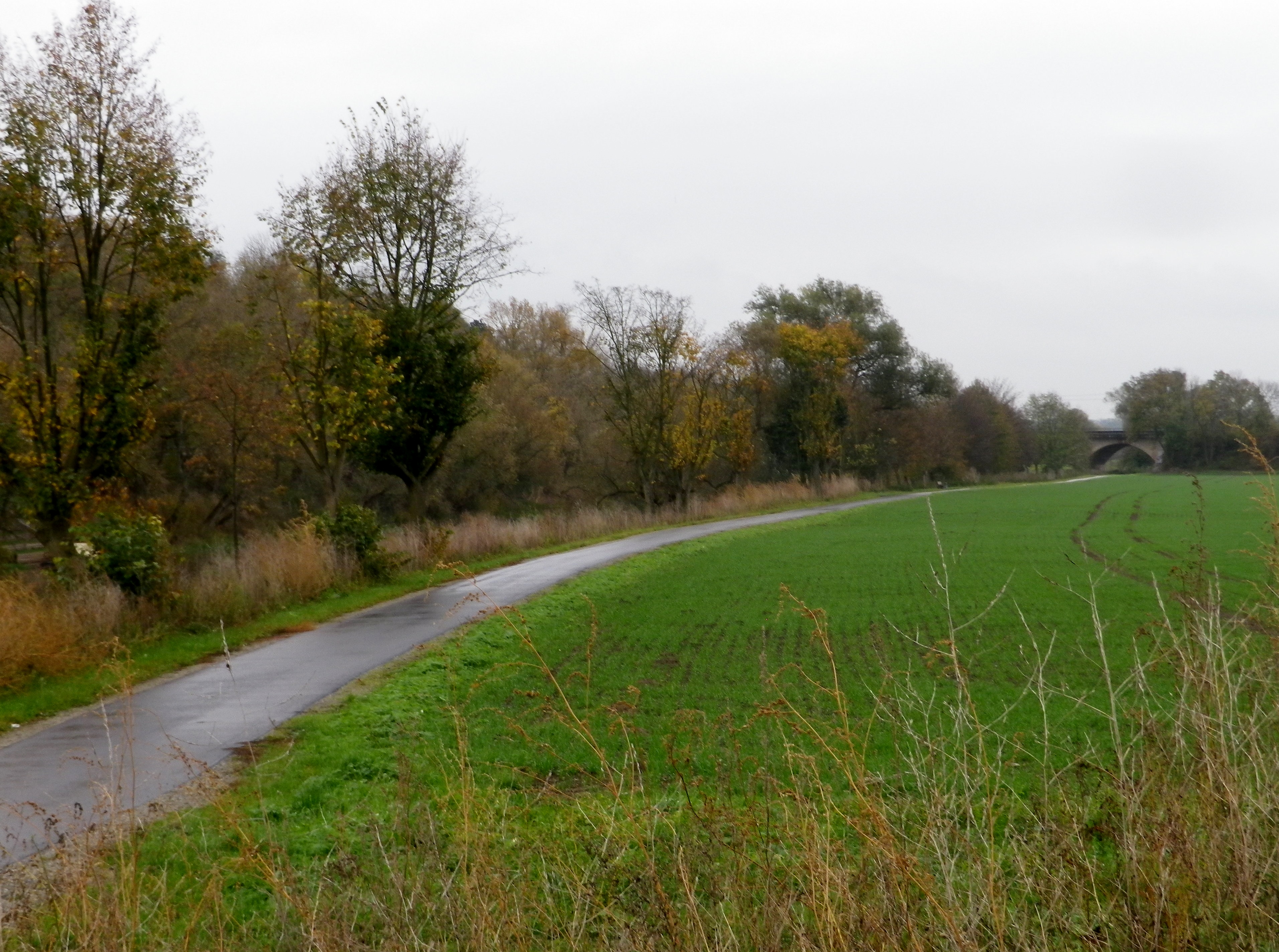
Another nice feature of this trail is the fact that it passes through some of the wine villages and towns in this region. The largest town in the area, Naumburg, has a nicely maintained historic district. It, and the cathedral, are worth a visit. Then there were a couple of villages. Kleinjena, opposite Grossjena on the Unstrut, comes next on the itinerary. Rossbach is a bit beyond Kleinjena. A settlement appropriately named Weinberge “vineyards”, follows, with its collections of vines suspended on the banks facing the Saale. Wine loving hikers will find several small, family run wineries along this sector of the trail.
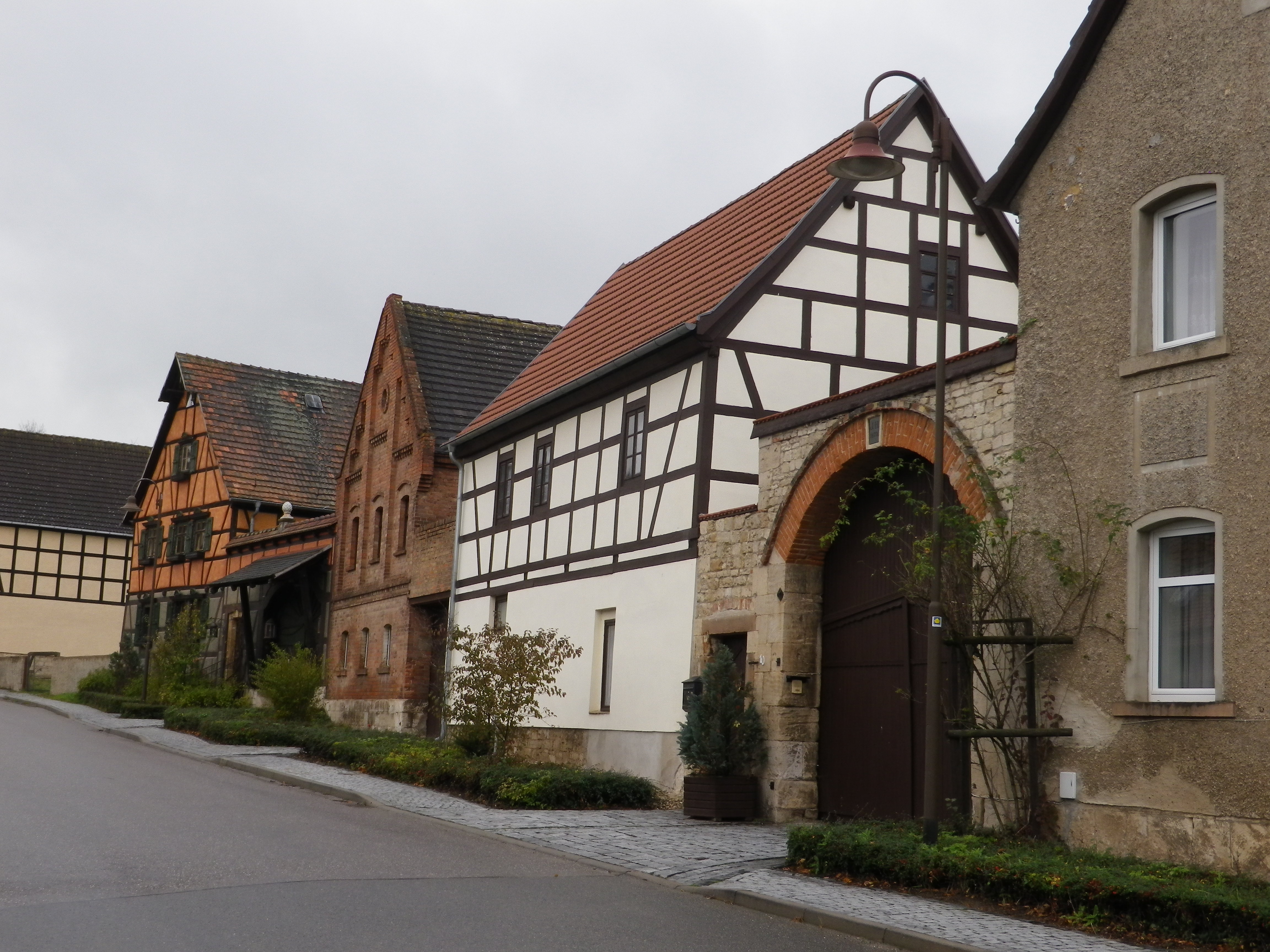
Before reaching Bad Koesen, Kloster Pforta appears on the trail. This old monastery building is now one of the largest local wineries. Its Saalhaeuser vineyard rise above it, and the river passes in front of it. The winery has a cozy a wine tavern collocated with it. Its little terrace looks out over the river, and on a nice day, would be ideal for sipping a glass or two of its wines. (The other large winery, the Naumburger Wein und Sekt Manufaktur, is in fact a still and sparkling wine firm located on the trail a bit further upriver in Henne-Naumburg.)
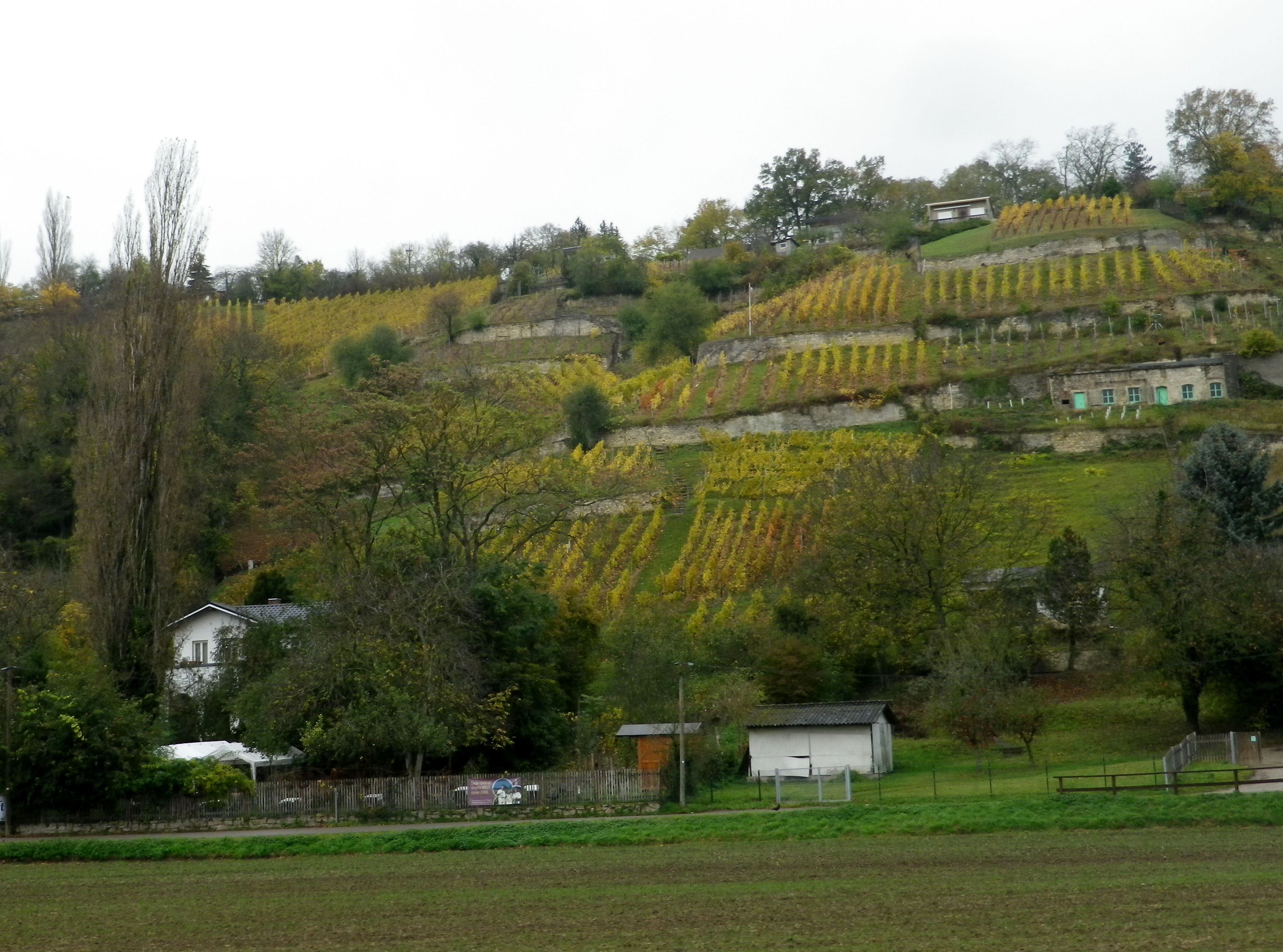
The trail returns to Naumburg via the bridge crossing at Bad Koesen. It is a small spa town on the Saale, to the west of Naumburg. In addition to being a spa town, with all the amenities found in any German spa town, there are several hiking trails in that district, and a least a couple of these focus on the vineyards. At the edge of Bad Koesen lies Schulpforte, formerly a Cistercian monastery dating to the twelfth century. (These were the monks who founded the original winery now found at the Kloster Pforta mentioned above.) After the abbey’s dissolution, the Duke of Saxony founded a school on the property. The impressive complex backs onto the side of a forested hill. The trail continues up that hill and through a forest for about two kilometers, back to Naumburg. (This was the part I could not hobble to, so I can’t write about the trail conditions.)
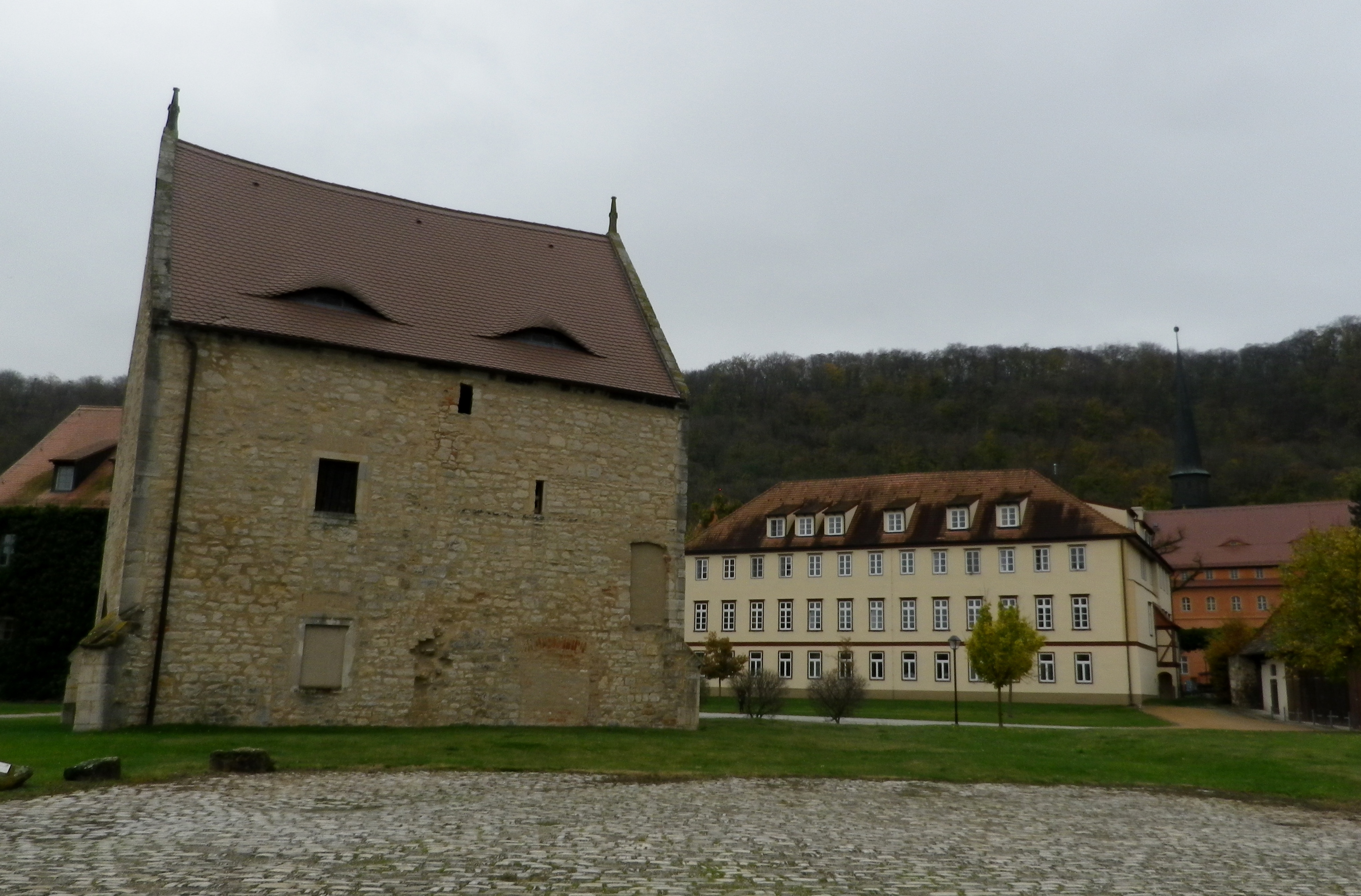
I completed my photo reconnaissance of this trail in less than an hour, vice two days. Thus, I had time to visit Colditz, and get lunch in a wine tavern. Over the rest of the day, and the next, I had opportunities to sample some Saale-Unstrut wines, and finalize plans to return some day to hike in the area, and taste more wines.
Wine Notes: Germany’s Saale-Unstrut
What I Learned
In 998 Emperor Otto III gave vineyards to Memleben Abbey, thus providing the first historic evidence we have of vineyards along the Saale and Unstrut.
The Saale-Unstrut winegrowing region covers some 770 hectares. The landscape is characterized by hills of shell limestone and variegated sandstone soils, often terraced, contained by centuries-old dry-stone walls.
Sited on the 51st degree of latitude, it is the northernmost designated quality wine region in Germany. The Saale Unstrut region extends over three German states: Saxony-Anhalt (639 hectares), Thuringia (108 hectares), and a real northern outlier in Brandenburg (by Potsdam) (8.4 hectares). Overall, the wine region receives about 1600 hours of sunshine, more than Trier in the Moselle wine region but less than Freiburg, in the southern Baden wine region in the Rhine River Valley. It gets about 500 milliliters of rainfall a year.
With over 50 grape varieties, the Saale-Unstrut wine region offers a wide variety of wines. Many of the grape varietals, both red and white, are known to do well in colder, wetter climates.
Of the white varietals, both Pinot Blanc and Müller-Thurgau, which can be surprisingly spicy here, lead by far in terms of production. Riesling, Bacchus, Gruener Silvaner, Pinot Gris, Kerner, Traminer and Gutedel, one of my favorite German whites, follow in order of quantity.
Red wine constitutes about 25 percent of all production, and comes primarily from Dornfelder (by far the most grown and vinified red varietal), followed by Portugieser; Blauer Zweigelt, and Spaetburgunder. Regent, one of my favorite German reds, is growing in popularity. One rare red varietal grown here only in tiny amounts is the André, which is a cross between the Blaufraenkisch (aka: Lemberger) and the Saint Laurent. It is difficult to find a bottle, or even a glass, of this wine.
There are over 50 private wine estates, and the Winzervereinigung Freyburg-Unstrut winegrowers’ association, the state-owned Kloster Pforta (over 850 years of wine-making), and the Wein und Sekt Manufaktur in Naumburg-Henne, and the Rotkäppchen Sektkellerei in Freyburg, both produce sparkling wines.
What I Tasted
2016 Spaetburgunder, Kabinett, Trocken, Winzerverein Freyburg (Unstrut): A dry red wine with medium plus ruby red color; slight red berry nose, with cherry, red berry, vanilla and oak flavors; medium minus tannins, with a smooth finish.
2015 Weiss Burgunder, Qba, Trocken, Landesweingut Kloster Pforta: A dry white wine with light gold color; floral and grass nose, with apricot, floral and grassy flavors; medium minus acidity, with a tart finish.
2015 Weiss Burgunder Kabinett, Trocken, Weingut Herzer (Rossbach): A dry white wine with light gold color; peach nose, with peach and toasted nuts flavors; medium minus acidity.
2015 Gruener Silvaner, Deutscher Qualitaetswein, Halb-trocken, Weingut Herzer (Rossbach): A dry white wine with medium minus gold color; a grass and herbal nose, with same flavors; medium minus acidity.
Source for the first section: https://www.weinregion-saale-unstrut.de/de/9/die-weine/rebsorten
Saale Weinwanderweg: Trail in a Nutshell
Trail Name: Saale Weinwanderweg
Trail Type: Mid-distance circuit hiking trail; well-maintained and mostly smooth surfaces, much of it paved, but no trail-specific marking on the trail
Length:
Total – 25 kilometers/15.5 miles
Convenient to: Leipzig, Germany
Marking:
No trail-specific marking
Trail Description: A very easy, if not a bit long trail, with only one ascent of any challenge, through the largely isolated vineyard areas between Naumburg and Bad Koesen, and those two urban centers. While the scenery is less spectacular than other trails, the attraction here is found in the quiet and very laid-back countryside of this little-known wine region of northern Germany.
Trailhead: Marienring x Hallesche Str, Naumburg, Saxony-Anhalt, Germany
Parking:
Naumburg (just before the river crossing to Henne): a medium sized unimproved lot
Grossjena: K233x Wasserstr, just after the bridge, a small unimproved lot
Bad Koesen: by the sports field at the trailhead, at the end of Hallesche Strasse
Public Transportation Options:
Rail: DB (DeutscheBahn) regional trains serve this area, and the nearest, and undoubtedly largest, hub for services in the county is Leipzig.
Bus: PVG Burgenlandkreis serves the area with a combination of tram and bus lines. Check the website for details.
Suggested Stages: Not applicable
Trail Itinerary-Reference Points: (Counterclockwise)
Naumburg:, Hallesche Str-Hallesche Anger, along the Saale, over river on Hallesche Str; Henne: past the Naumburg Wein und Sekt Manufaktur, road turns to path; Along Bluetengrund toward Grossjena; Cross Unstrut after 500 meters passing the Max Klinger Museum entrance; Kleinjena: Friedrich-Schulze Strasse, Unter den Reussen, path; Rossbach: Pass St Elizabeth church, Am Leihdenberg, Am Meisel, Trift, Weinberge; Pass the Steinmeister vineyards, Pass the Besenwirtschaft Dierking, Along Saale on Weinberge-Saaleberge, Pass Klosterpforta; Bad Koesen: Saalstr, cross the bridge, Naumbergerstr/B87, An der Kleinen Saale; Schulpforte; woods, Panoramaweg, Koesener Str, Michaelisstr, Lindenring, Herrenstr, pass the town hall on the main square, Marienstr.
Representative Trail Photos:
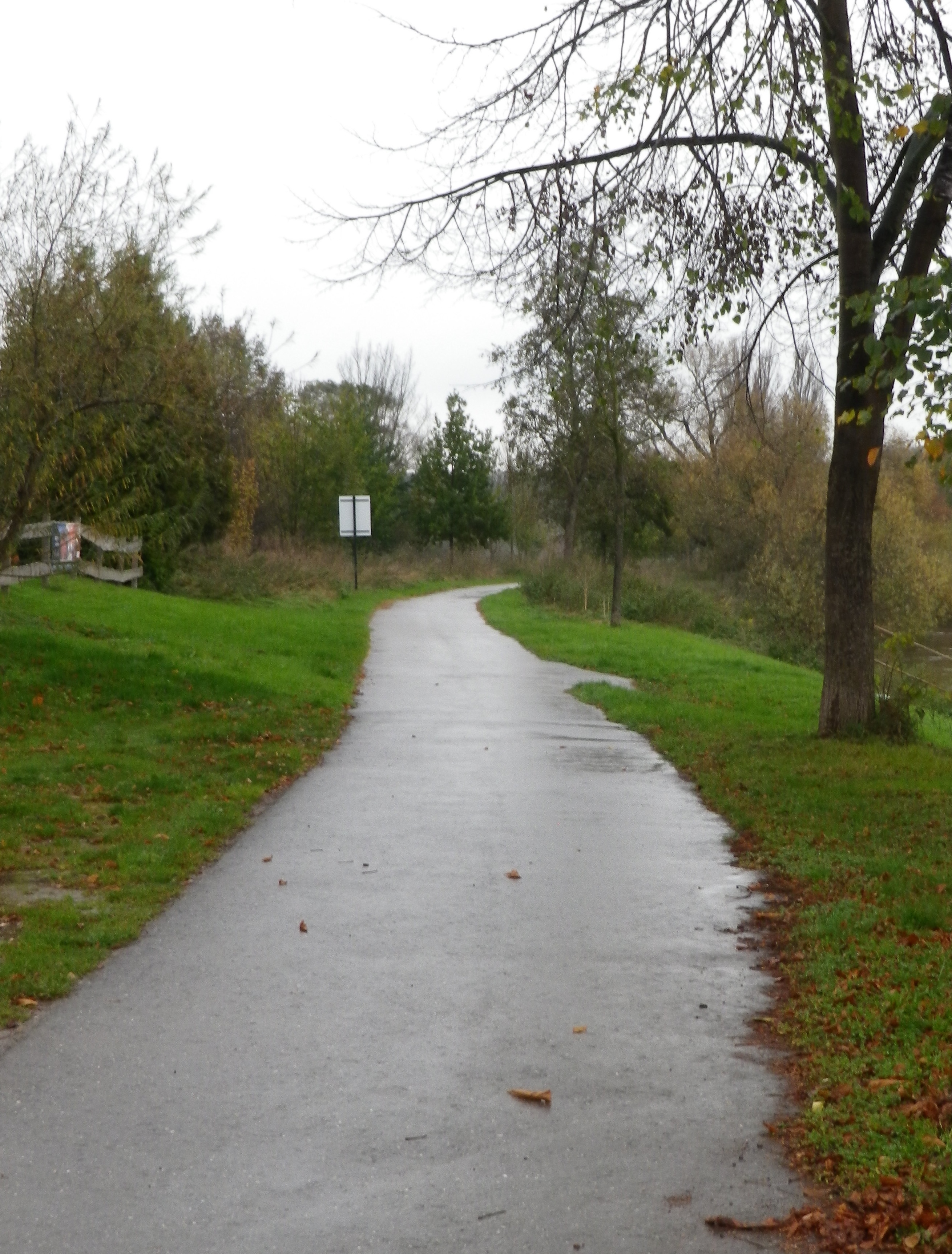
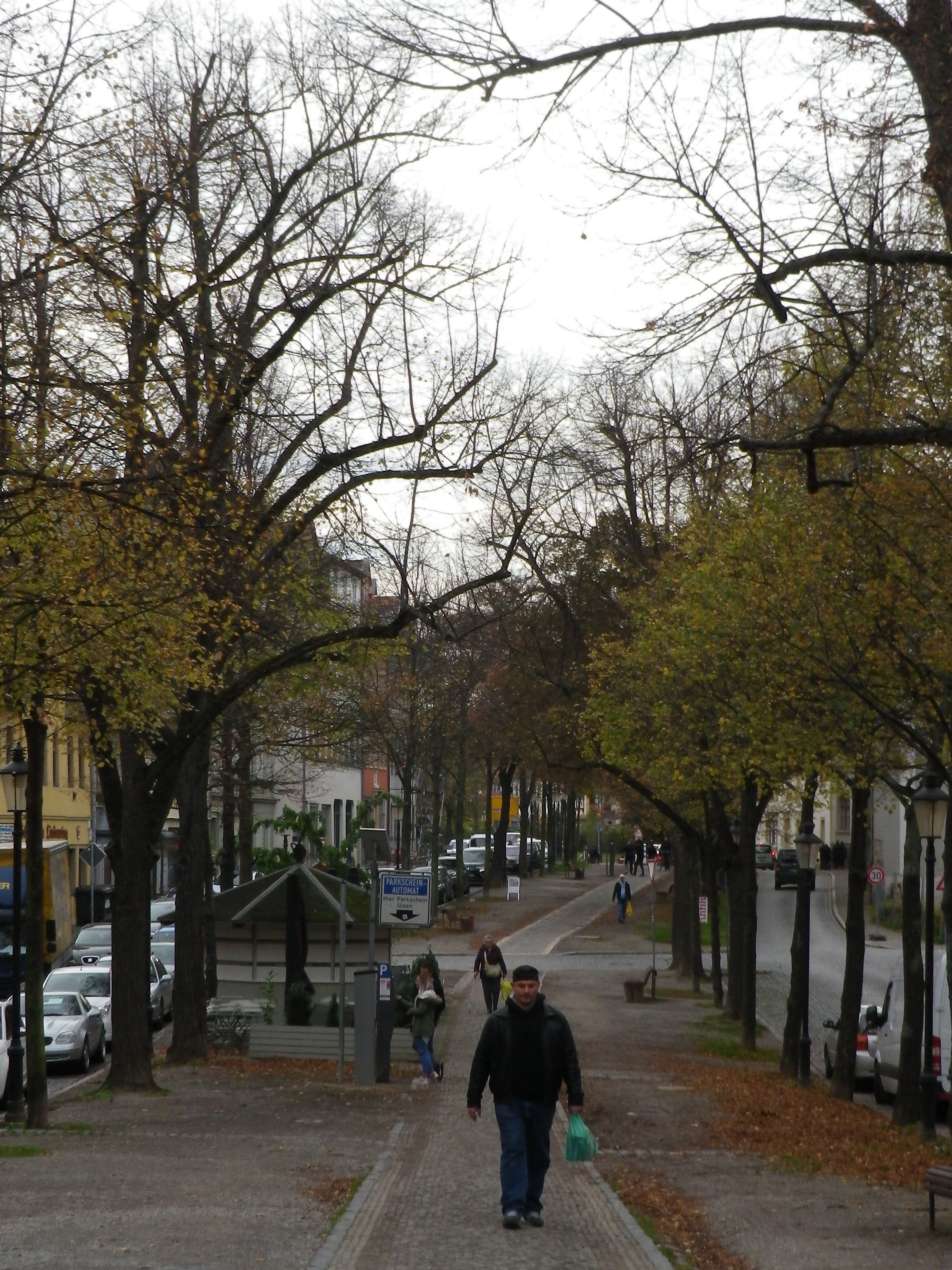
Restrooms:
No public ones observed
Attractions on or near Trail:
Max Klinger Museum, just outside Grossjena, dedicated to a well-known local artist, who also had his own vineyards on the grounds.
The local wine museum is located between Grossjena and Freyburg, in Schloss Neuenburg, a mile or so off the trail.
Tasting along the Trail:
Trail boasts numerous vintner establishments along the way, but the Wein und Sekt Manufaktur in Naumburg-Henne, Kloster Pforta, Schulpforte, and the wineries between Rossbach and Bad Koesen, are your best opportunities to purchase bottles.
Alternative Options:
Hiking:
-Weinlehrpfad Saale-Unstrut, a 12-kilometer (7.4 mile) trail along the vineyards on the Unstrut, starts in Laucha, and finishes by the bridge in Freyburg.
-Weinbergsweg, an 11-kilometer (6.8 mile) circuit around Bad Koesen, some of which is on the Saale Weinwanderweg.
Biking: The long-distance Saale Radweg, while not wine-themed, passes many of the wineries mentioned above, and is used by this hiking trail in part.
Additional Information:
Regional:
http://www.weinregion-saale-unstrut.de/ for wine tourism information concerning this wine region
https://www.saale-unstrut-tourismus.de/ for tourism in general in the Burgenland Kreis county
Trail specific: https://www.outdooractive.com/de/route/wanderung/saale-unstrut/saale-weinwanderweg-ab-naumburg/1405756/#dm=1
Comments:
Due to a knee injury, I did not hike this trail itinerary, so I cannot comment on the ascent or the wooded section of this trail between Bad Koesen and Naumburg.
Bubbles!
The Alsatians call their sparkling wines Cremant. But these were not the only bubbles (“bulles”) that I found along this “Bulles et Bugatti” cycling itinerary. There were wineries and taverns offering the Cremant of Alsace, of course. But equally enjoyable were the bubbling creeks along much of the way, from the Dachsteinerbach, the Bruche and its canal, the Mossig, Frankenbach and Kehlbach, finally, the Stillbach, (it wasn’t), a melodious stream bubbling its way to the Bruche.
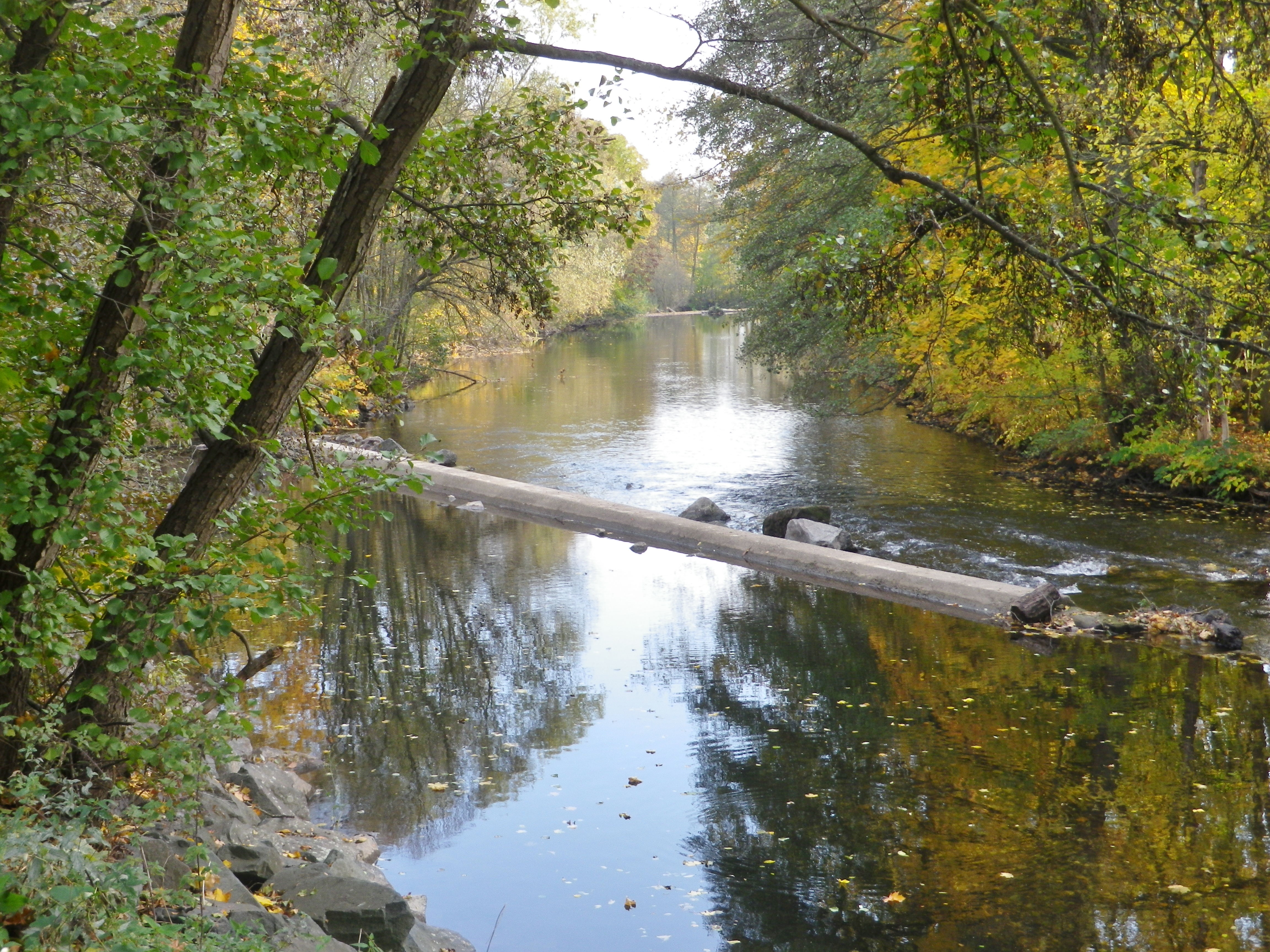
The Bruche empties into the Ill, a tributary to the Rhine, by Strasbourg. Starting in the Vosges mountains, it ultimately flows by the vineyards in the foothills of the Vosges, before entering the flat fields surrounding Strasbourg. This geography lesson just to let you know that the itinerary did have some hills, but also some very flat stretches. Especially memorable for its peaceful, rural aspect was the section riding along the Bruche Canal, a paved and beautifully maintained bike path. It is even possible to follow this trail all the way to the heart of Strasbourg!
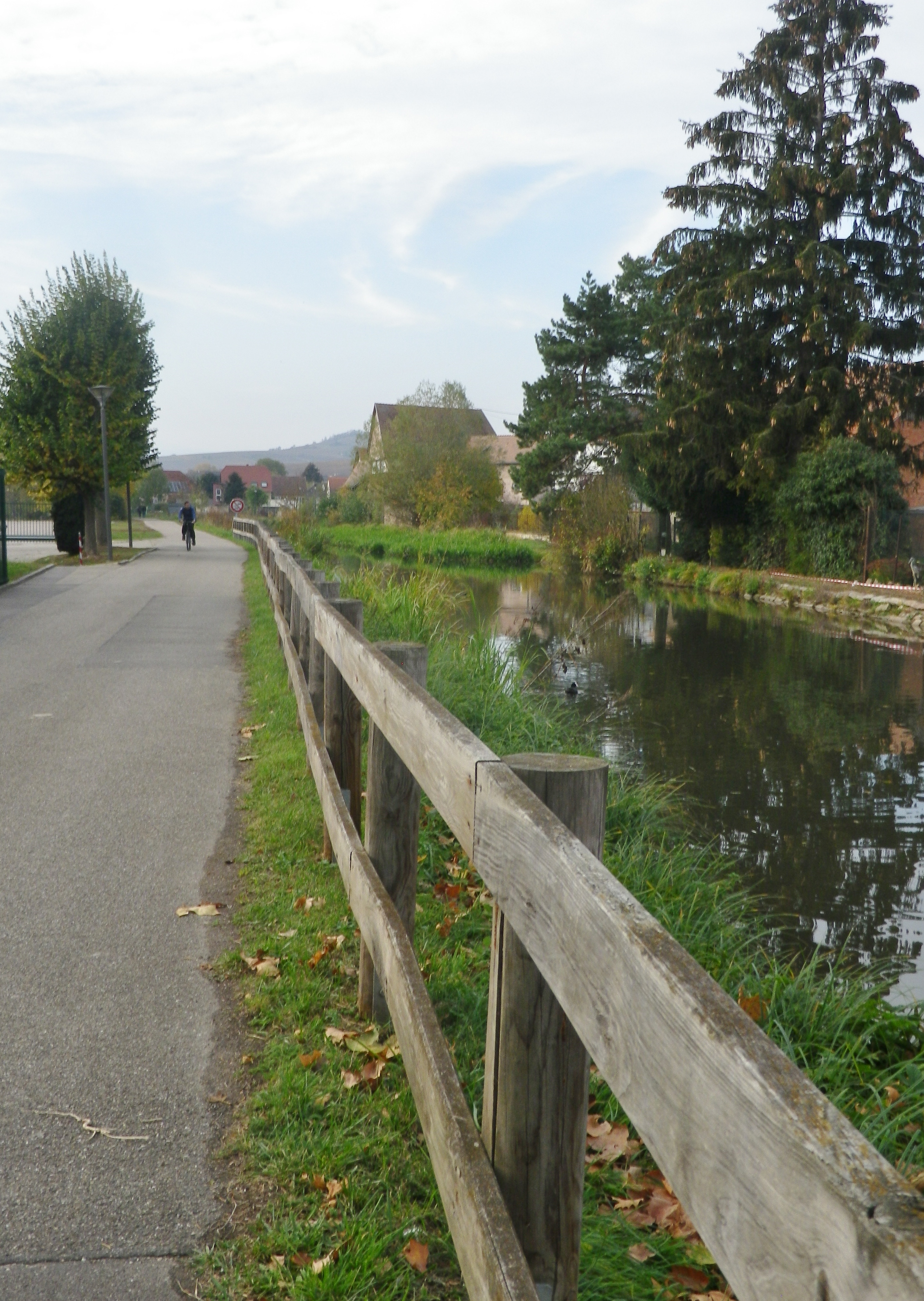
But this itinerary also included the hills and dales in the heart of the Bas Rhin vineyards. Departing Molsheim, and passing Dachstein, a medieval walled and effectively moated village, the ride proceeds mostly on a flat bike path, which is a delight, to the canal. The hills begin where the canal ends, at Soulz-les Bains.
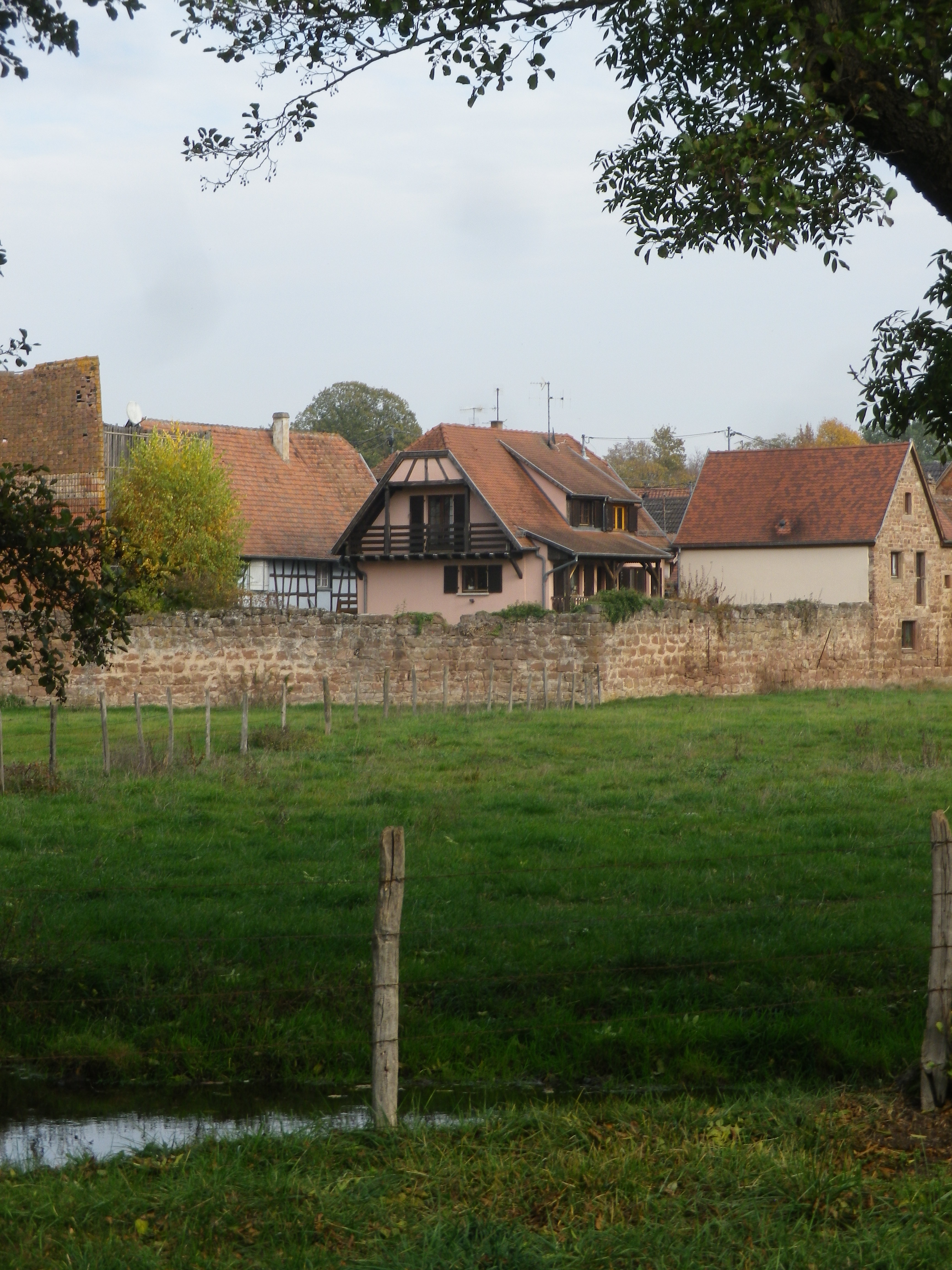
As the name implies, there is a spa in Soulz, a small village with a wonderful bakery, and Lucien Doriath’s excellent restaurant dedicated to foie gras. (Don’t worry, you can work it all off while on the numerous hiking and cycling trails passing through the village.) In addition to the Bruche and its canal, the Mossig also runs through this area. In fact, this whole itinerary sits in a watershed, and water is impossible to avoid.
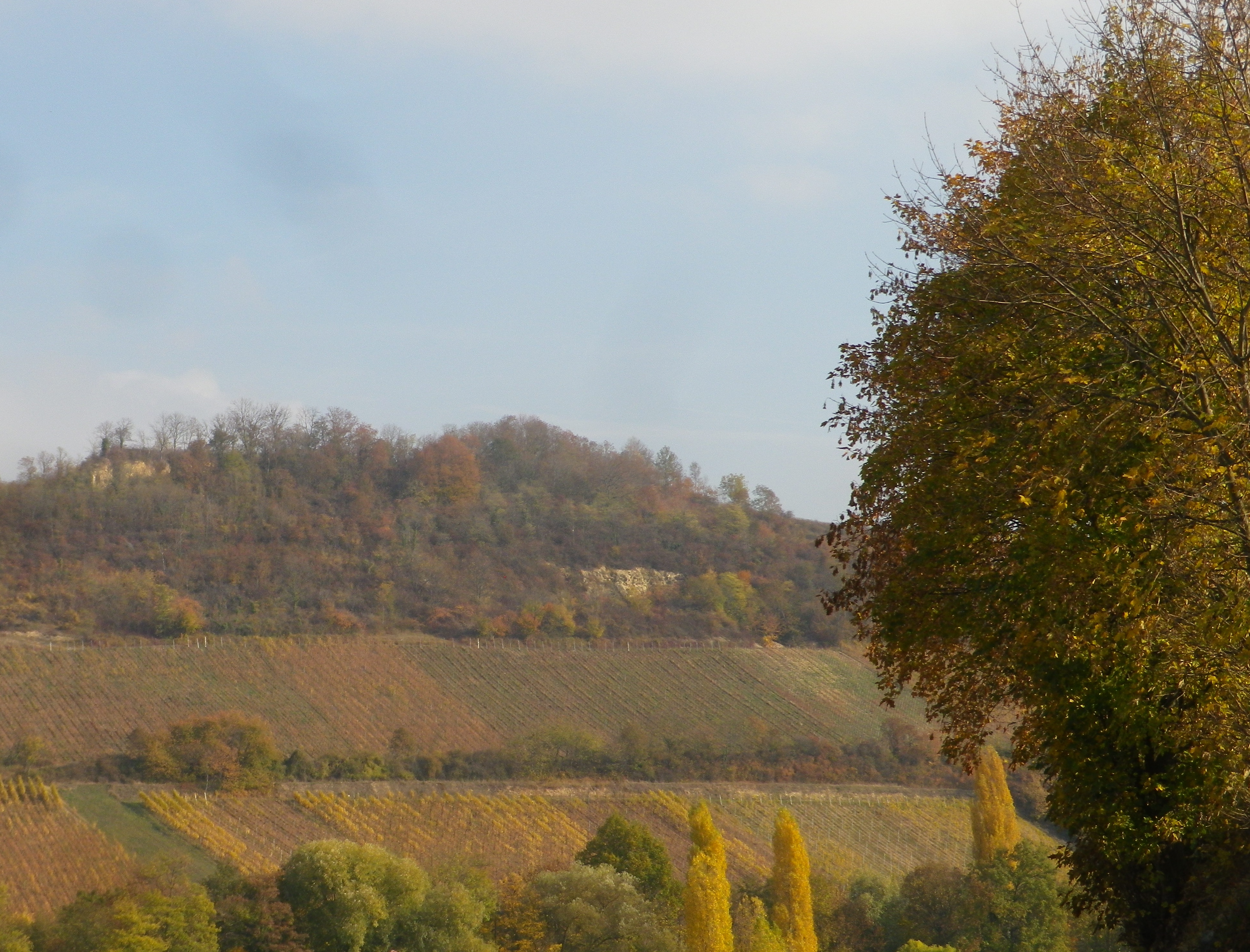
From Soulz, the itinerary climbs. As it does, vineyards replace fields, and the wine village of Bergbieten with its Grand Cru vineyard appears. Balbronn, another well-known wine village, is picturesquely surrounded by vineyards. Between there and Flexbourg, the higher elevations of the Vosges mountains come into view providing magnificent photo opportunities.
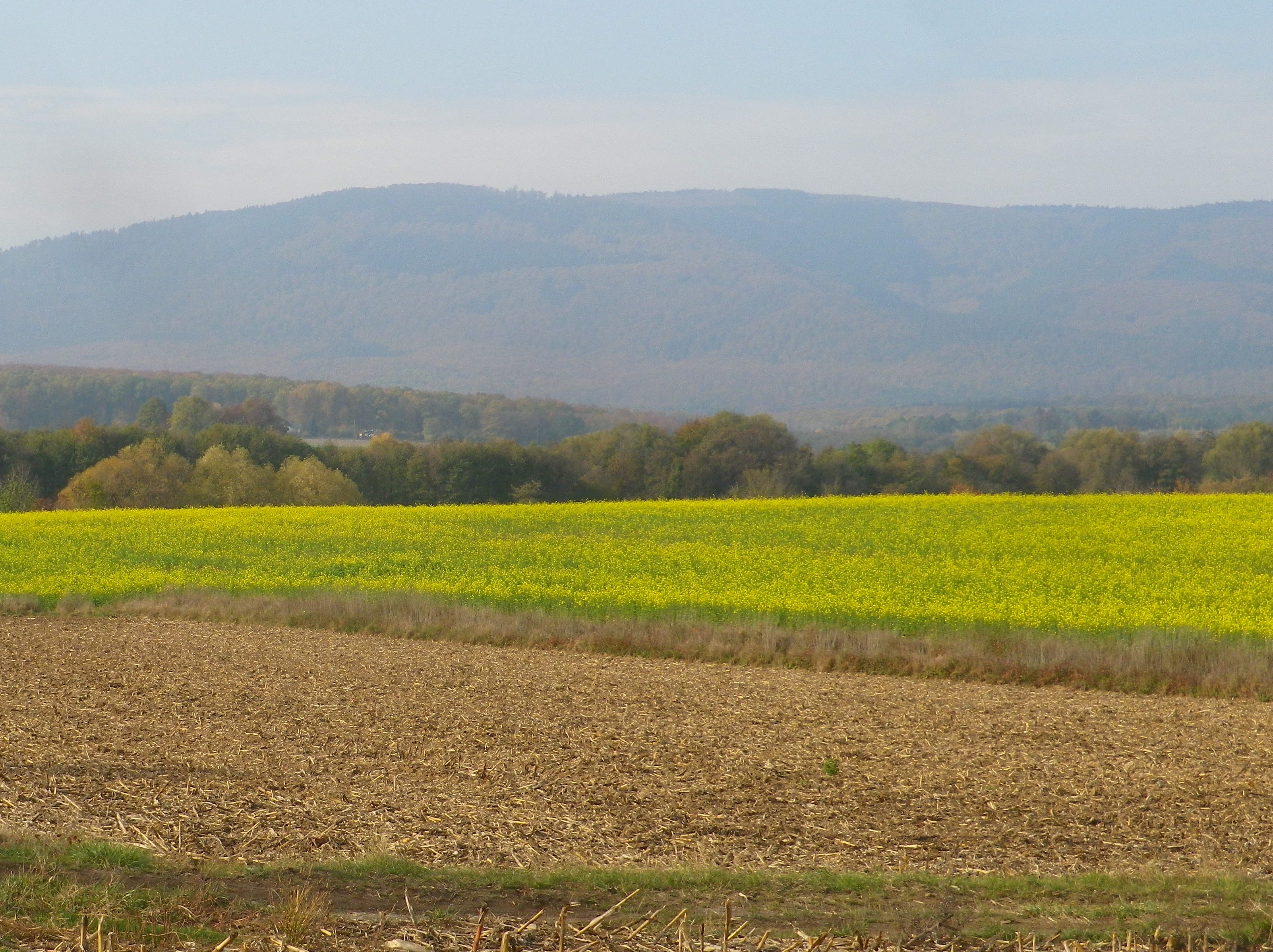
Once out of the hills, more rivers and streams appear. A marvelous confluence of several of these appear on the approach to Dinsheim sur Bruche. I cycled along the Stillbach, to where it joins the Bruche, then over the Muhlbach to cross the Bruche once again just before re-entering Molsheim. On the outskirts is the Bugatti factory. Bugatti was founded in Molsheim, and it still produces fantastic cars of distinction there. I must confess though, I saw few cars, much less Bugatti ones (the least expensive model starts at over two million dollars), while cycling, making this a relatively car free itinerary overall.
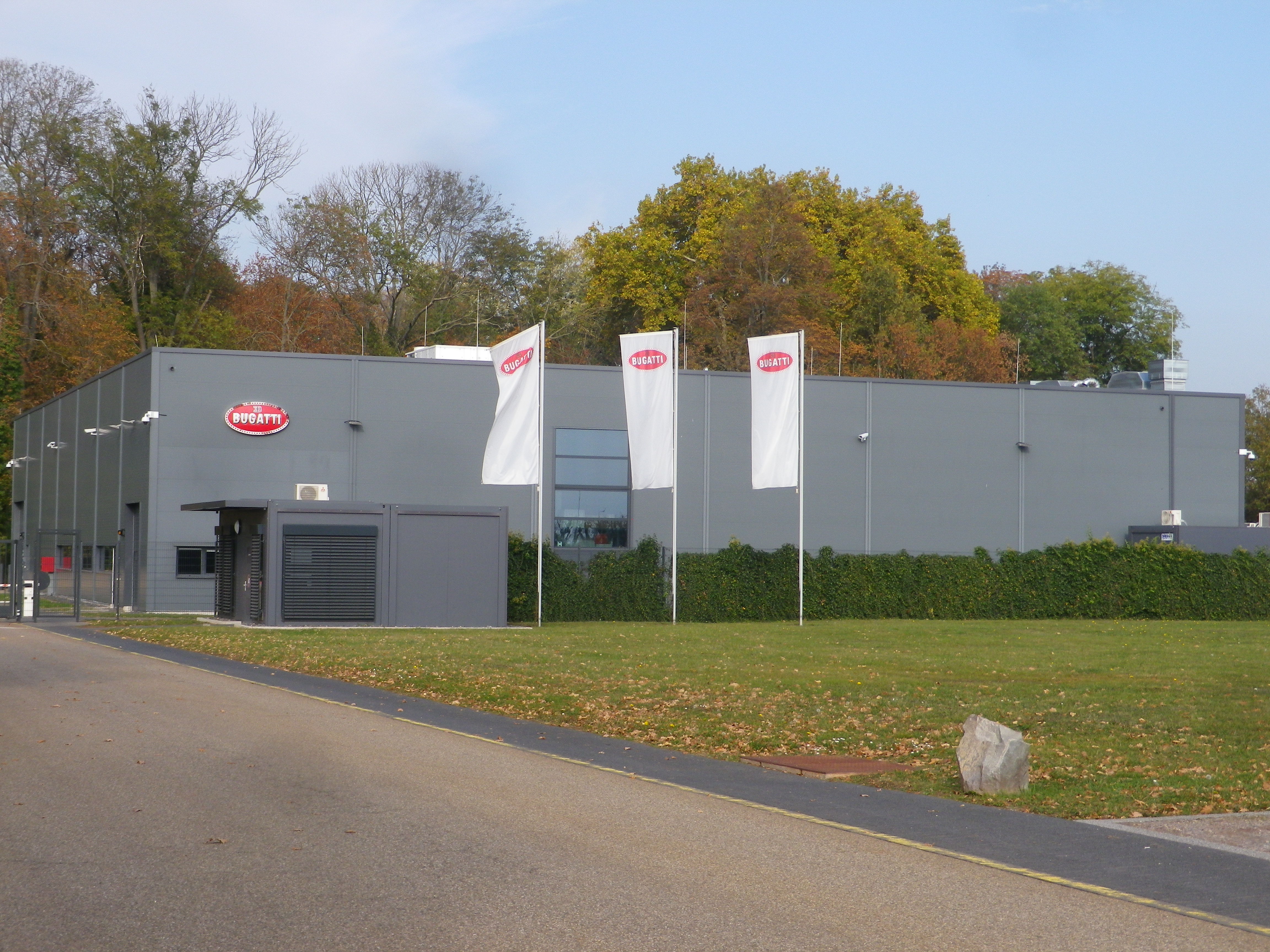
Molsheim is a small town, but the largest in this area. It is known to the wine world as the site of the Grand Cru Bruderthal, a “production” site as much esteemed locally as the Bugatti plant. The town itself boasts a couple of charming squares, fronted by historic and attractive half-timbered buildings. It is a nice place to base, if spending some time in the area. It has several restaurants serving good food and local wines, as well as a couple of wineries. Fortunately, all food and wine offerings, even the Cremant d’Alsace wines, cost only miniscule fractions of the cost of a Bugatti, hence may be happily enjoyed by all!
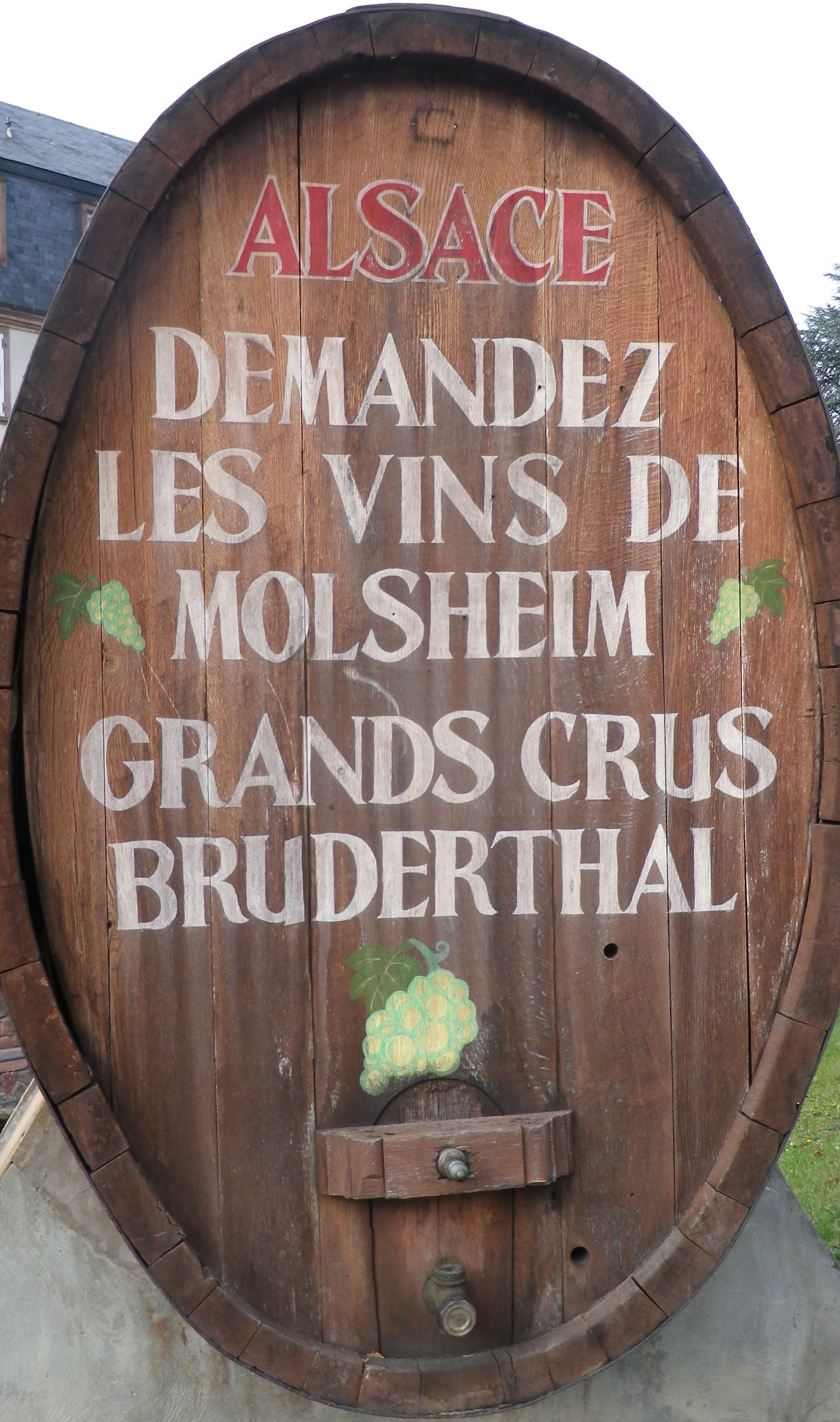
Wine Notes: Alsace’s Crémant
What I Learned
The Alsatian wine region is famous throughout France, and the world. It is a great place to try excellent white wines, at very reasonable prices. In addition to the still wines made from the six main white varietals grown in Alsace – Riesling, Sylvaner, Gewuerztraminer, Muscat, Pinot Blanc, and Pinot Gris – sparkling wines are produced here.
Crémant is the name for the Alsatian sparkling wine made using the Champagne method. But unlike most Champagnes, Alsatian winemakers traditionally use Pinot Blanc, Pinot Gris and Riesling to produce the classic Alsatian crémant. (Riesling brings a nice touch of acidity, as well as fruitiness to the blend, and is a unique addition to French sparkling wines.)
Vintners here also make good use of some of the other appellation Alsatian varietals. Some cremants use Pinot Blanc exclusively. The Rose cremants are made with exclusively of Pinot Noir (the only red appellation varietal grown in Alsace). Additionally, for the specific Appellation Crémant d’Alsace, Auxerrois and Chardonnay grapes may be used.
The appellation Crémant d’Alsace dates to 1976, and currently represents almost a quarter of Alsace’s total wine production. While the most well-known Alsatian crémant producer is Wolfberger, located in the Haut Rhin department, there are some Bas Rhin producers who consistently produce excellent sparkling wine as well. In the Bas Rhin, the cooperative winery Cave du Roi Dagobert, produces a nice line of Crémant. (Their winery (in Traenheim, less than ten kilometers/six miles from Molsheim) offered a wonderful tasting of their Crémant line, but unfortunately, I lost my tasting notes. Suffice it to say, they were all delicious and very reasonably priced.)
What I Tasted
Crémant, Dagobert Prestige, Demi-Sec, Appellation Crémant d’ Alsace Controlee, Cave du Roi Dagobert (Traenheim): A semi-dry white sparkling wine with fine, swirling, persistent bubbles and light gold color; floral and yeast nose, with floral and toast flavors; very smooth with mild acidity.
Crémant, Chardonnay, Brut, Appellation Crémant d’Alsace Controlee, Domaine Robert Klingenfus (Molsheim): A dry white wine with very fine bubbles, and medium gold color; floral and slight yeast nose, with floral and bread flavors, medium acidity.
2018 Cuvee d’Antoine, Domaine Robert Klingenfus: A dry white wine cuvee (mostly Pinot Gris, and a bit of Riesling), with medium minus gold color; a Riesling nose, with pear and floral flavors, high minus acidity.
2018 Pinot Gris, Signature, Appellation Alsace Controlee. Domaine Robert Klingenfus (Molsheim): A dry white wine with medium plus reddish gold color; a rich floral and spicy nose, with flavors of ripe peaches, roses, and vanilla and nutmeg spice; medium acidity, very smooth finish
2015 Gewürztraminer Glintzberg, Vendanges Tardives, Domaine Anstotz et Fils (Balbronn): A dry white wine with dark gold color; rich aromatic nose, with powerful lychee and concentrated exotic fruits flavors; mild acidity. (201908)
2015 Riesling, Westerweingarten, AOC Alsace, Domaine Anstotz et Fils (Balbronn): A dry white wine with medium plus gold color; a mineral nose, and peach and spice flavors, with a hint of turpentine; medium plus acidity.
2011 Riesling, Altenberg de Bergbieten, Grand Cru, Appellation Alsace Controlee, Domaine Roland Schmitt: A dry white wine with medium gold color; intense nose of spice and white fruit; citrus, floral and spice flavors; a full-bodied wine with medium acidity. (Tasted in 2014)
Bulles et Bugatti: Trail in a Nutshell
Trail Name: Bulles et Bugatti; AKA BL 312
Trail Type: A mid-distance circuit bicycle itinerary; well-maintained surfaces, much of it paved, however no trail specific marking throughout the itinerary.
Length:
Total – 33 kilometers/ 20.5 miles
Convenient to: Molsheim, Strasbourg, Bas Rhin, Alsace, France
Marking: None specific to the itinerary. Some sections do have the typical green and white cyclist markings for a bicycle path to serve as a guide.
Trail Description: A well thought out itinerary through mostly rural landscapes with a variety of flat and hilly sections, vineyard, field and urban terrain, some on minimally trafficked road sectors, and some on fairly long stretches of vehicle-free bicycle path or dedicated bicycle lane.
Trailhead: Molsheim, Rue de Strasbourg, Porte des Forgerons
Parking:
Molsheim: R de la Commanderie x R Ernest Friedrich (closest to trailhead); Rue des Sports, by the open-air pool
Dorlisheim: Chemin des Moissons, Rue Mercure, north and south, in a mall area
Mutzig: Place de la Gare, Rue du Dr Schweitzer,
Balbronn: R du Fronhof (at the upper/higher end)
Public Transportation Options:
Rail: Frequent regional trains (TER) connect Strasbourg and Molsheim
Bus: Numbers 234 and 236 connect Molsheim with surrounding villages
See the comment below
Suggested Stages: Not applicable
Trail Itinerary-Reference Points: (Counterclockwise)
Molsheim: R. de Strasbourg x Avenue de la Gare, R. Charles Mistler, past Camping Municipal, over Bruche, along D93/D30; Dachstein: D30; Egerstein: Along Canal de la Bruche to Wolxheim; Wolxheim : R de Molsheim; Avolsheim: cycle path to Grotte d’Avolsheim, R. du Dompeter, R. de la Gare, Impasse de la Roseliere, cycle path; Soultz les Bains: R. de Molsheim/D422, D275: Dangolsheim: D275/Rte du Vin (past the Lavoir, or laundry basin); Bergbieten: D275/Rue des Vosges; Balbronn: D275/R. du Château, R. de la Foret, Rte de Flexbourg; Flexbourg: Rte de Flexbourg-R. des Acacias, R. de la Paix, R. des Seigneurs/D118; Still: D118/Rte de Flexbourg, Grande Rue; Dinsheim: D118, D392/ R. du General De Gaulle, past the Chapel of St Wendelin; Mutzig: Blvd Clemenceau; cross the Bruche, still on D392, past the Gare de Mutzig, Rte de Strasbourg; Faubourg des Vosges; Dorlisheim: Grand Rue, Avenue de la Gare/D392; Molsheim: D392; Altdorf: Chemin de la Blieth, R. des Romains, R. des Pres, R. Principale; Molsheim: R. Jean Mermoz, cycle path paralleling Rte Ecospace, D2422/R. de la Commanderie, past the Gare de Molsheim
Representative Trail Photos:
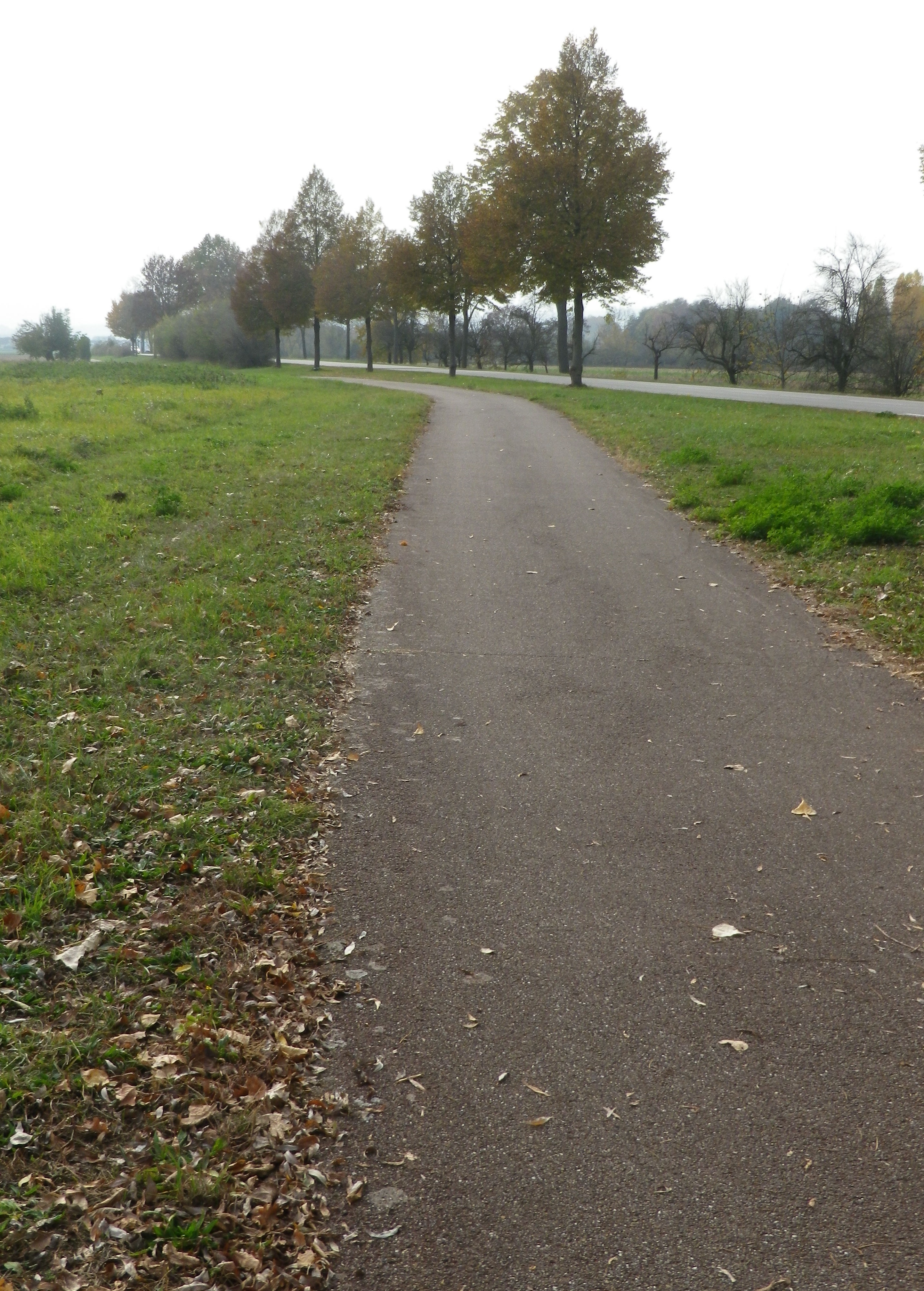
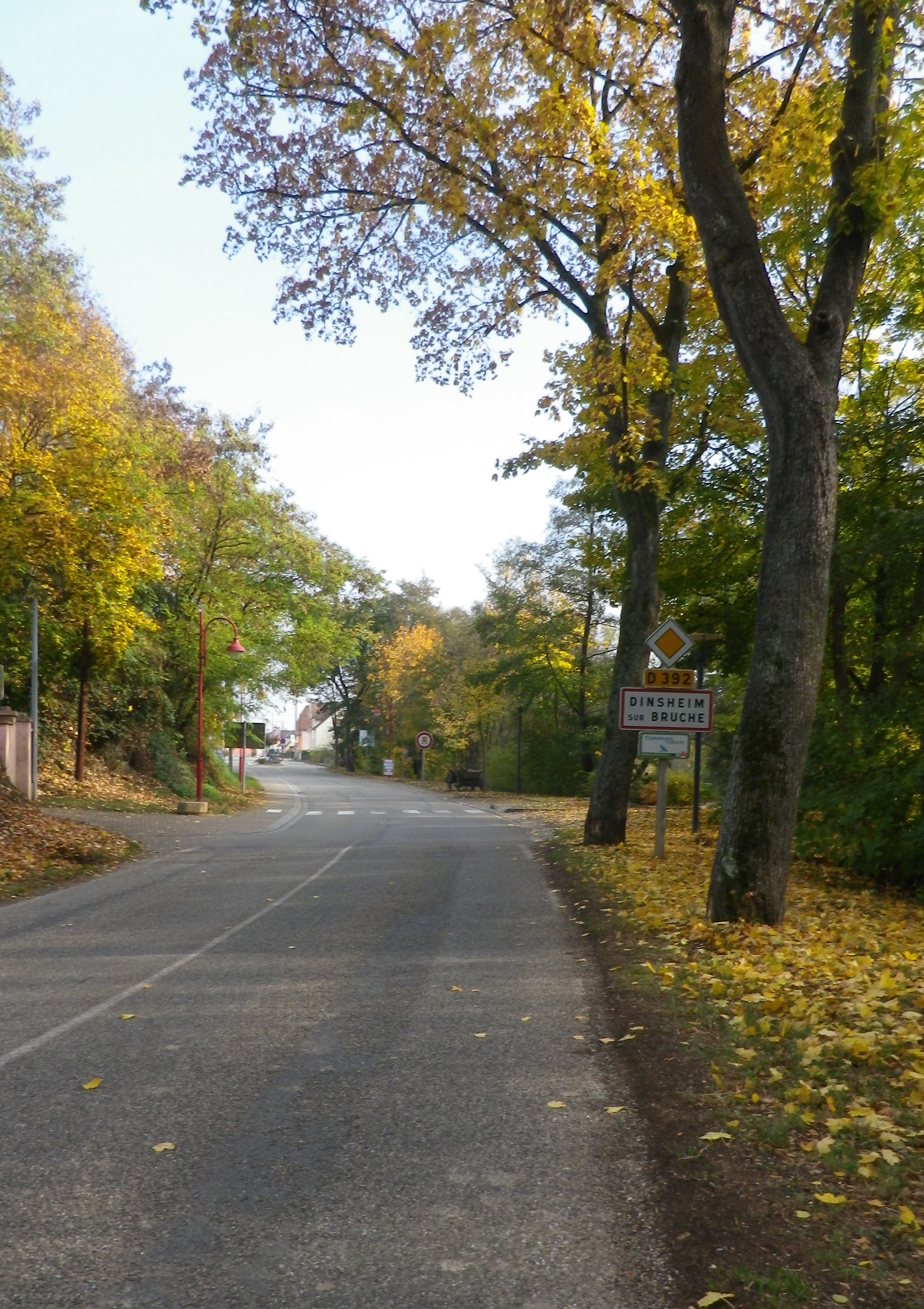
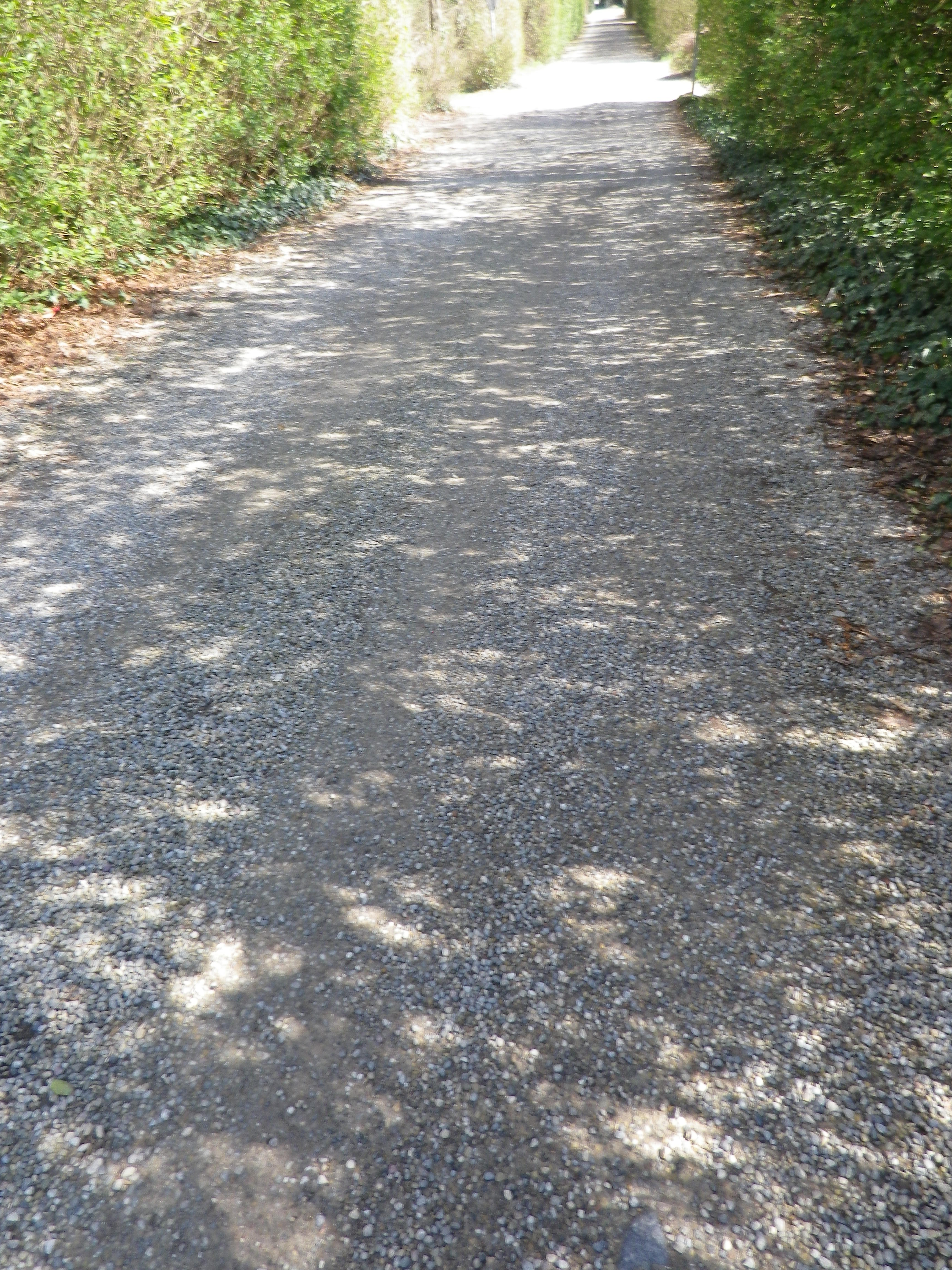
Restrooms:
Molsheim: Passage de la Post x Avenue de la Gare, about 50 meters west of the chapel in the parking lot by the old town gate “Tour des Forgerons”
Attractions on or near Trail:
Molsheim: Musee de la Chartreuse, focuses on millennia of history and traditions of the Bruche Valley, while another section covers the history of Bugatti (the other half of the name of this route), its cars and its connection to Molsheim.
Tasting along the Trail:
Wolxheim, Avolsheim, Soulz-les-Bains, Balbronn and Bergbieten are well-known wine villages with several wineries in each. Additionally, Molsheim is the largest town in the area, with several taverns and restaurants serving local wines.
Alternative Options:
Hiking: The circuit hike called Trotele, one of the Circuits of Bacchus, is a 13.6 kilometers hike through several of the same villages. See the Nutshell here.
Biking: The long distance Veloroute du Vignoble d’Alsace begins about 15 miles north in Marlenheim, and passes through Soulz-les-Bains, Molsheim and Dorlisheim, then proceeds south through other villages and towns in the Bas Rhin department. See the Nutshell here.
Additional Information:
Regional: http://www.ot-molsheim-mutzig.com/
Trail specific: https://www.alsaceavelo.fr/itineraires/boucles-locales/bl312-bulles-et-bugatti-118.html
Comments:
Although the bus and train network is good here, the 20.75 kilometer cycling path Veloroute du Canal de la Bruche (https://www.alsaceavelo.fr/itineraires/veloroutes-des-canaux-et-vignoble/veloroute-du-canal-de-la-bruche-23.html) is a fantastic and easy way for visitors in nearby downtown Strasbourg to reach this particular itinerary and this little visited vineyard area.
